AIFFRO K100 SSD NAS Review – N100 Powered Flash NAS for Your Pocket?
AND ANOTHER SSD NAS has arrived on the market, this time from AIFFRO with their K100 4-Bay NVMe micro/pocket server. Nowadays, it seems like every brand and it’s subsidiary want to get in on ALL SSD NAS systems! The decreasing cost of SSDs, combined with the rising efficiency of server CPUs have all added up to a lot of brands appearing on the scene out of the East to introduce their new NAS system for Flash storage. Add to this the fact that many of them do not need to include an operating system, thanks to the rising use of the likes of UnRAID and TrueNAS, which means that they can be incredibly competitive with their pricing! But the last 12 months have been a massive spike in the development of NAS systems that have their hardware/brand routes in mini PC development. But where is the line? What sets a NAS system apart from a mini PC? Just the storage? The AIFFRO K100 blurs the lines considerably with it’s N100 CPU architecture, 4x 2280 M,2 SSD slots and 2.5GbE connectivity, arriving at $320. So, let’s review this new micro NAS, see how/if it differentiates itself well enough from a cheap mini PC and hopefully help you decide if the K100 deserves your data!
|
Where to Buy?
|
| Component | Details |
|---|---|
| Model | K100 |
| Dimensions | 117x112x34mm |
| Material | Aluminum alloy |
| CPU | Intel N100, 4 cores, 4 threads, 6MB cache, peak clock speed of 3.40GHz |
| Video Engine Processor | Intel UHD Graphics 12th |
| Memory | LPDDR5 8GB 4800MHz (4x2GB LPDDR4 4800MHz Micron MT62F1G32D2DS) |
| Storage | 4 x SSD (2280 M.2 PCIe Gen3x4, downgraded to 3×2) |
| I/O Ports | 2 x USB 2.0, 2 x TYPE-C USB3.2 Gen2 Data Only 10G, 1 x TYPE-C DC, 1 x 2.5G RJ45 Realtek RTL8125, 1 x HDMI 1.4 |
| Ethernet | Realtek RTL8125, 10/100/1000/2500 Mbps Ethernet |
| LED | 1 x POWER LED (Power On: Green+Red, working: Green) |
| Adapter | Automatic Voltage adjustment between 100 and 240V AC, 50/60Hz, 65Watts PD (20V/3.25A), 1.5 meters long Type-C cable |
| Support System | CentOS/Euler/Ubuntu/Win11/FreeNAS/TrueNAS |
| Accessory | VESA Mount (optional) |
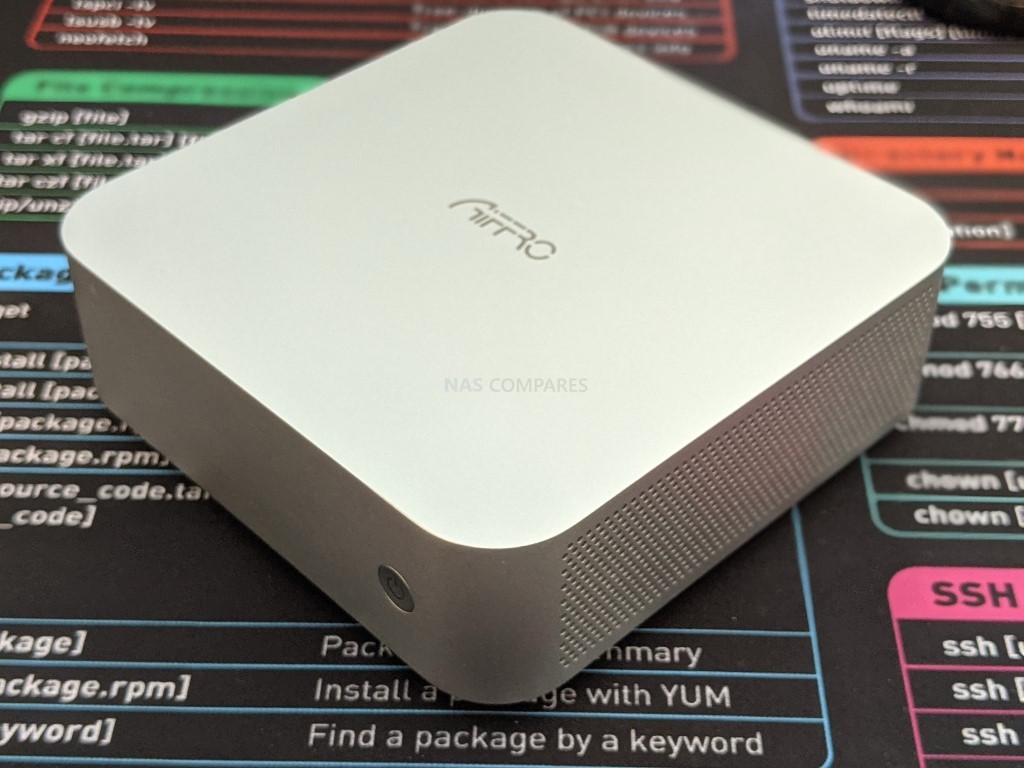
AIFFRO K100 SSD NAS Review – Quick Conclusion
The K100 4-Bay NVMe SSD NAS is arguably quite an average NAS system, but it stands out by being one of the very few compact NAS systems that arrives at under $300 with dedicated m.2 NVMe support. There is no avoiding that very little has been done to separate it from being just a Mini PC that happens to have 4 storage slots – but at the same time, with complete NAS OS freedom, lower power consumption with USB power, good sustained performance internally (though peak performance is weak) and being genuinely pocket-sized, make this system an interesting NAS for those looking at a truly portable NAS. The single 2.5G slot is a pain though (i.e no failover and 250-279MB speed limit externally) and the fixed 8GB memory feels restrictive for TrueNAS users (let’s not even bring up ECC…), but as a first NAS from this brand on the market, it still brings competitive hardware pricing to the table. They just need to make more of a concerted effort to truly make this into a NAS system in the conventional sense. Definitely a brand to keep an eye on, but this is a system for hobbyists and homelabber’s who want something more capable than a raspberry Pi, but not for mission-critical data.
Where to Buy a Product





![]()
![]()

VISIT RETAILER ➤






![]()
![]()

VISIT RETAILER ➤
 DEAL WATCH – Is It On Offer Right Now? DEAL WATCH – Is It On Offer Right Now?These Offers are Checked Daily
|
AIFFRO K100 SSD NAS Review – Design
The K100 arrives in a predictably small, Mini PC-esque form. Given the scale of modern m.2 NVMe drives, even at the largest capacity, this system does not really need to be particularly large when focusing on this media. There is, of course, the balance between keeping things quiet and compact versus keeping things cool and smoothly running, but there are a decent number of design choices here that balance this point quite well.
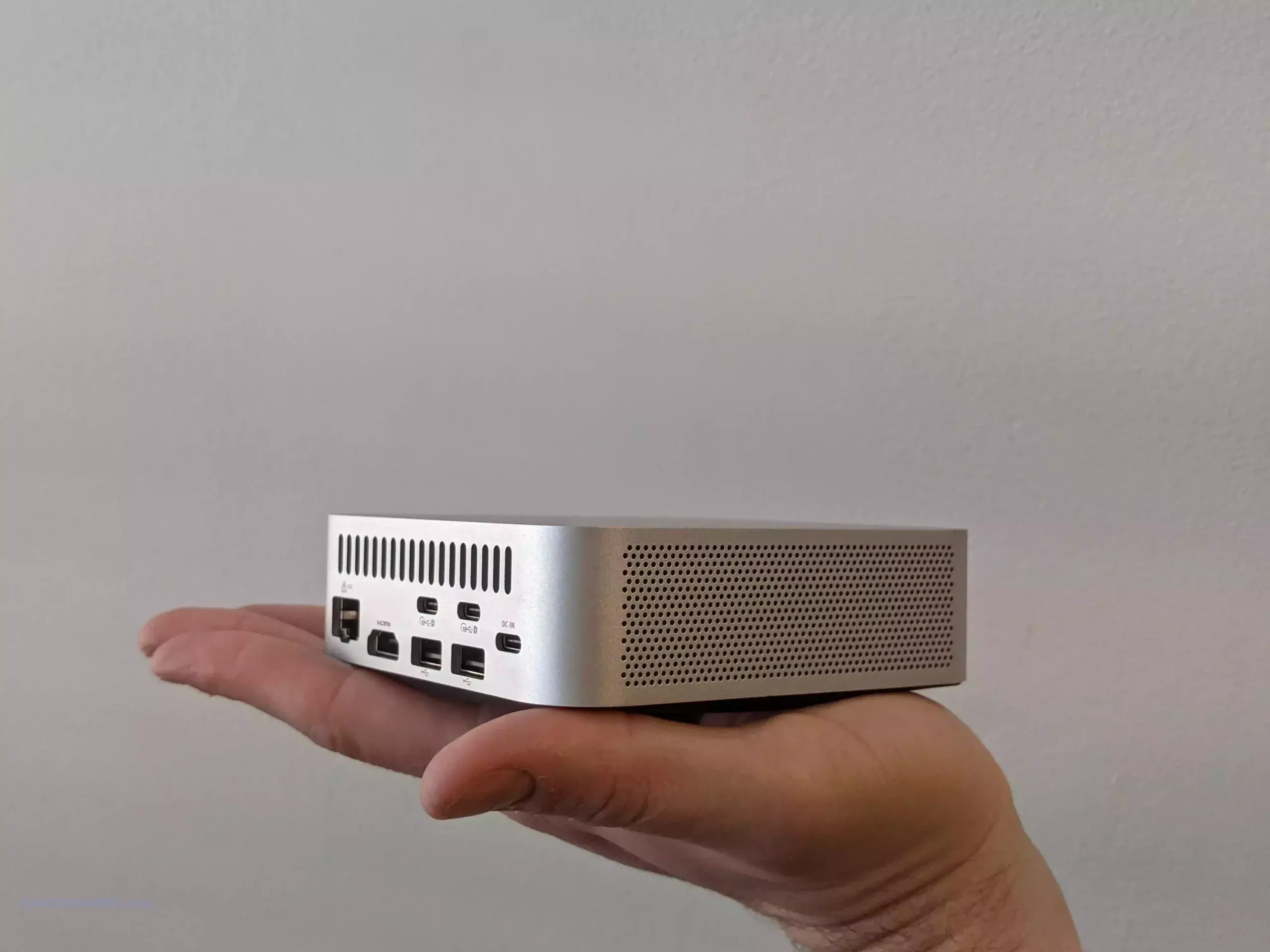
The enclosure is metal on all sides. The base has ventilation holes on three of the four sides. The system features only a single internal active cooling fan that we will touch on later on, but it is all very discreet and the silver metallic finish is a nice touch.
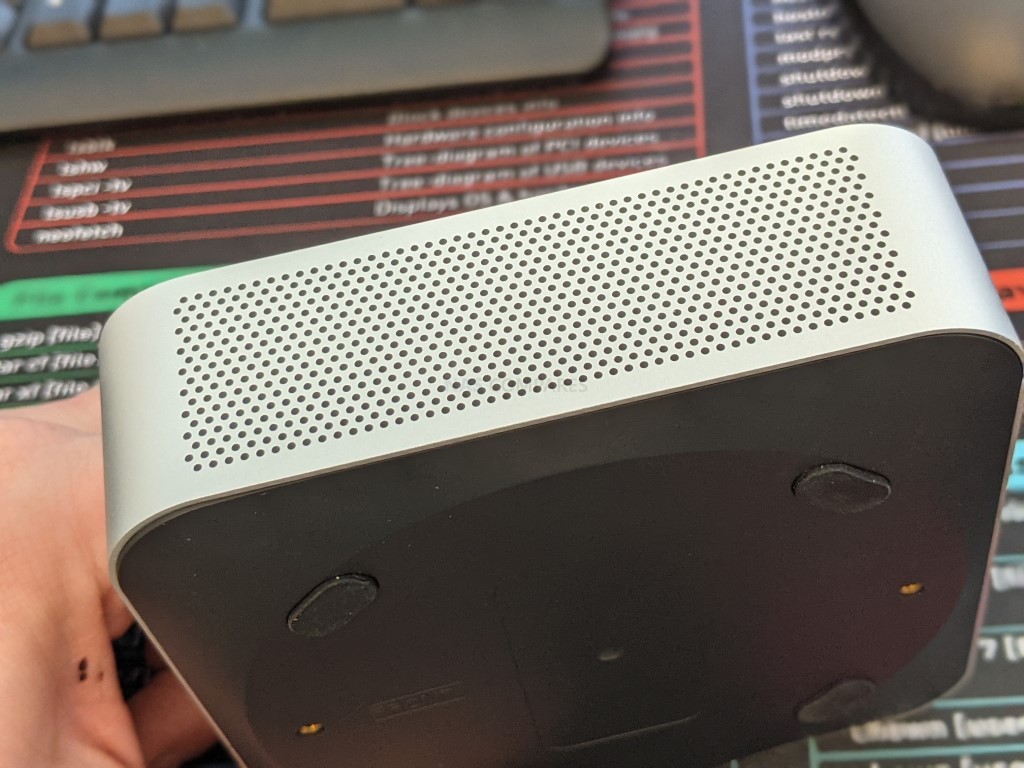
Measuring at just a little under 12 cm by 11 cm by 4 cm, this is a tremendously small-scale NAS system that, thanks to its use of USB power delivery, means it is going to be extraordinarily low impact on your hardware environment when deploying. Likewise, weighing in at around half a kilo, it is going to be pretty easy to mount this device anywhere. The front of the system is quite nondescript and only features a single power button and no further connectivity. Given the preponderance of USB connections that we will touch on later, it would have been nice to have one of these ports front-mounted for convenient local backups or storage injection as needed.
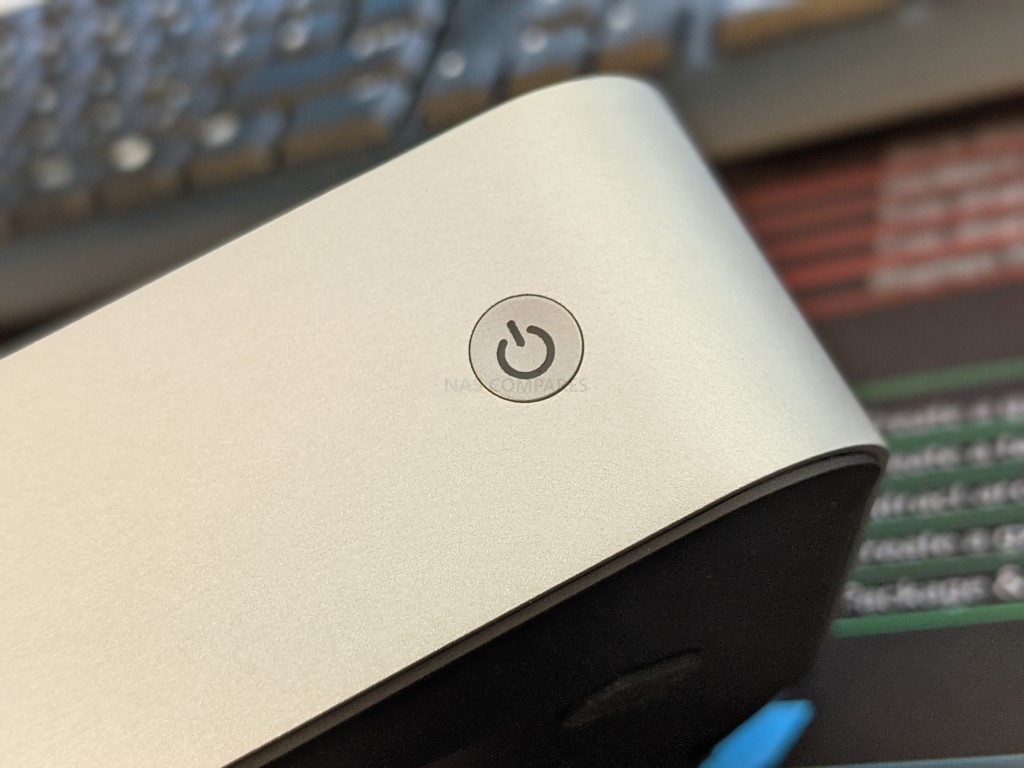
The base of the system is a plastic panel with rubber feet that can be removed via four screws to access the internal storage bays. Overall, the design is very understated and, despite the more modest N100 architecture, the K100 still manages to be impressively small-scale.
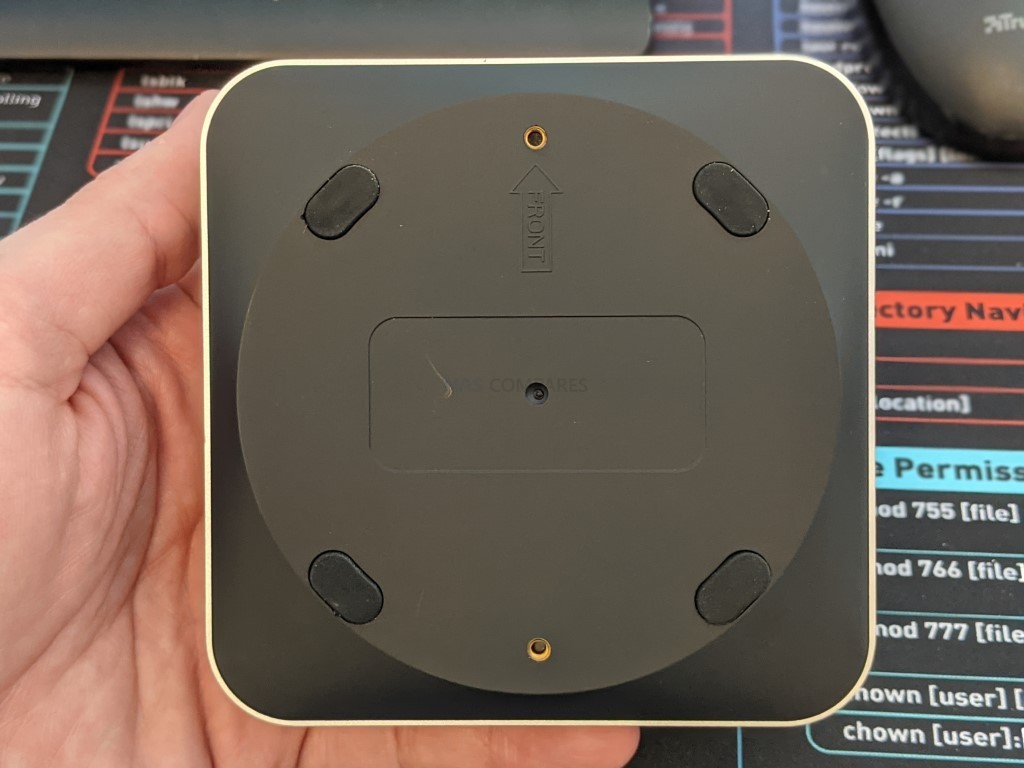
The K100 feels very well-built and impressively put together. There is no avoiding that this chassis does look like a slightly modified Mini PC enclosure, but that is not necessarily a bad thing for those that want a service system that focuses exclusively on m.2 SSD storage. Let’s discuss the external connectivity of this device.

More so than the scale of this system, the ports and connectivity of the K100 bring back that slightly icky feeling that this is just a mini PC pretending to be a NAS. It’s not that the connections are bad, it’s just that in one very specific area an obvious feature of modern NAS is absent. But before we get to that, let’s keep things positive. The rear of the system is actually pretty densely packed with connections, and interestingly, the system even runs on a standard USB type-C power connection. You will need to deliver slightly more than your average USB-connected port, but I was able to run this system pretty well with my Sharky external battery pack and even a standard 36 W USB phone charger kept this system running. Obviously, it is recommended that you use the included PSU to run this system, but having USB type-C power certainly adds an element of flexibility once again to the deployment of this system.
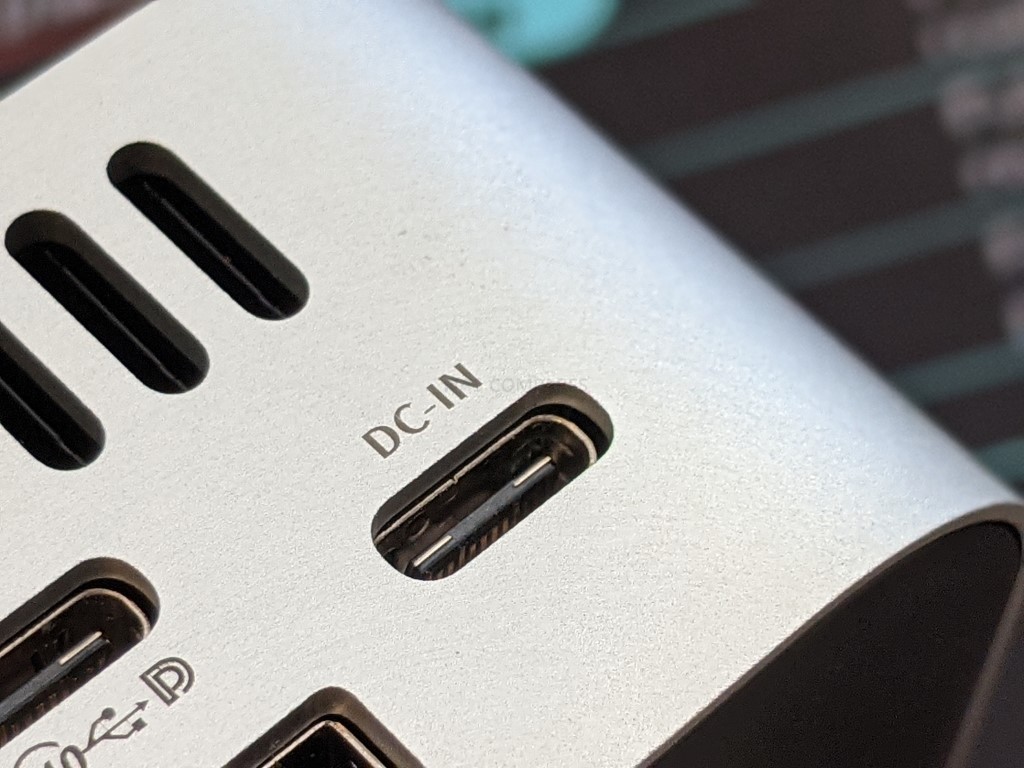
Additionally, there are further USB type-C and USB type-A ports, with the former providing you with 10 GB performance with externally connected storage drives and the latter being a useful means to set up your KVM for direct access on this system with your visual output. Again, USB type-C is surprisingly rare on modern NAS devices and in this compact frame makes a lot of sense.
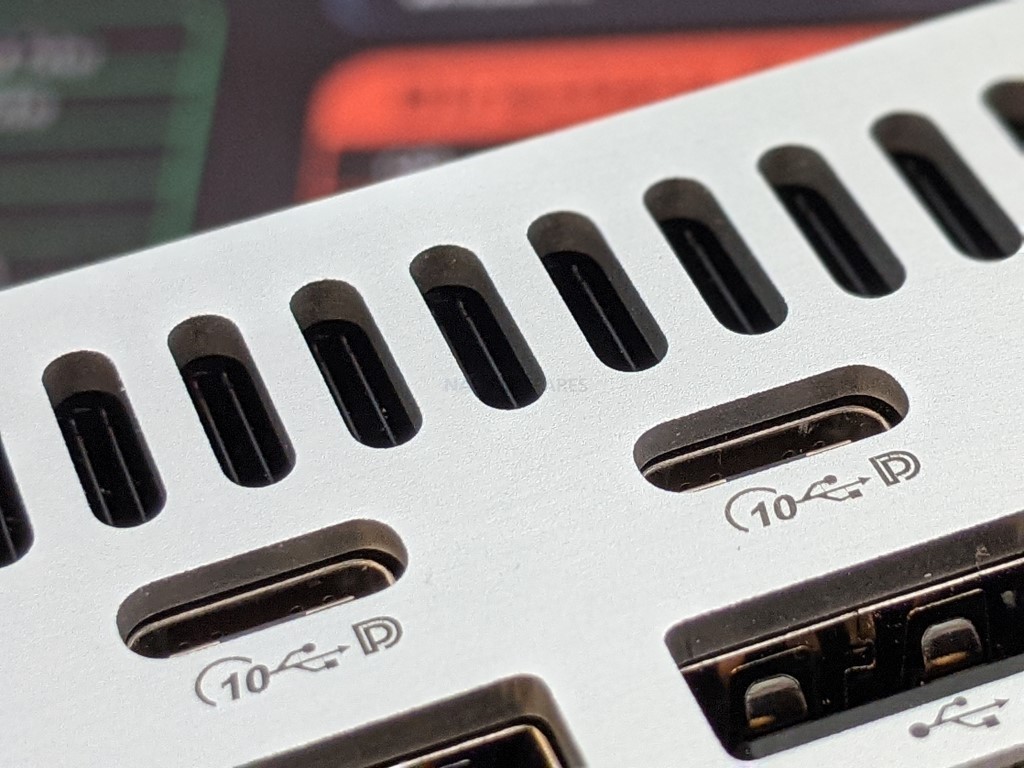
There are also dual HDMI outputs, which of course are going to be heavily dependent on the NAS operating system you use, but it’s still a useful thing to have here and they do output 4K at 60 frames per second. Alongside multimedia, these ports can also be used in conjunction with accessing the BIOS of the system easily to install the third-party NAS software that you want to use. So far I have tested TrueNAS Core and Unraid on this device, and both ran fine.
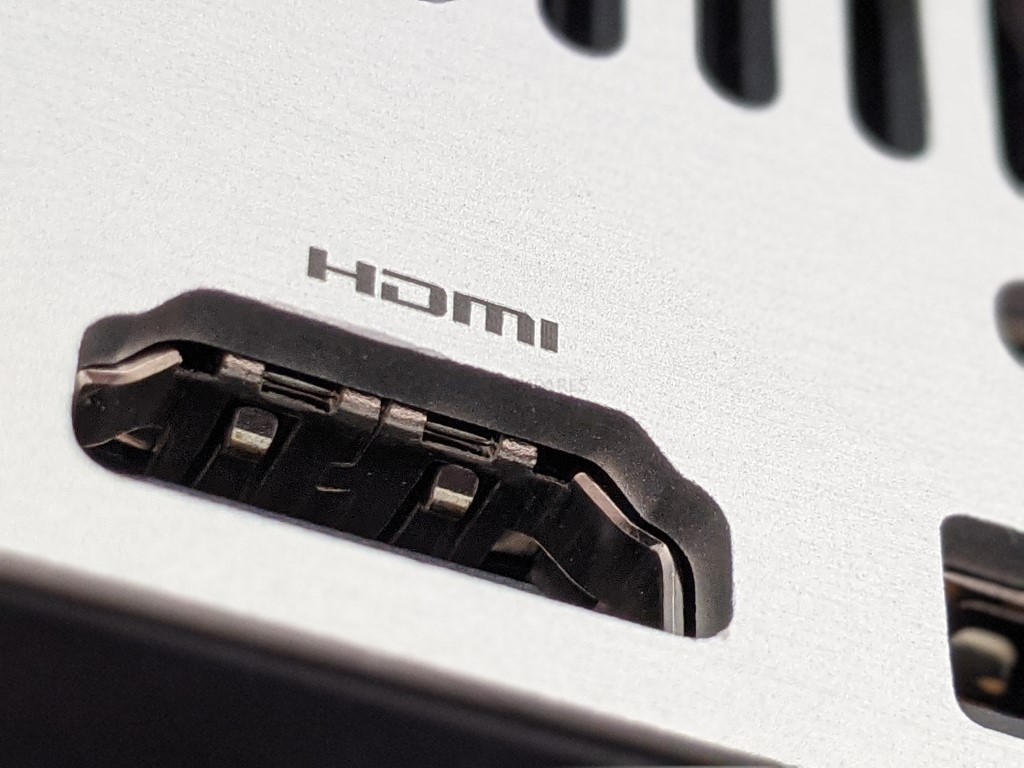
However, now it’s time to get a little down in the dumps and talk about the network connectivity on the K100. Despite the fact that this system supports four m.2 NVMe SSDs inside, and even arrives with a reasonably powerful, yet efficient N100 CPU, the K100 arrives with a single 2.5 GB Ethernet port. That means that all data transmissions outside of this device are going to be bottlenecked to around 250 to 270 MB per second. Although the tiniest bit of me wants to give them the benefit of the doubt and at least highlight that it is not standard boring 1GBE, there is no avoiding that alongside this port, ensuring a huge bottleneck of the performance that this system could reach, the lack of any option towards failover, link aggregation, and easy SMB multi-channel for Windows users is simply going to be impossible here.

Clearly, they have opted to prioritize m.2 NVMe storage inside this system, even going as far as to ensure that each slot has 2000 MB per second bandwidth afforded to it for those SSDs (more on that later), but a single Ethernet port of this calibre is just not going to be enough for most users who are choosing to invest a few extra dollars in SSD media over that of hard drives. Hell, even if this system was running on traditional 3.5-inch hard drives in SATA and not m.2 NVMe drives, it would still massively oversaturate a single 2.5 G NIC.

Now, it isn’t quite the end of the road in terms of network connectivity. There isn’t any kind of PCIe upgradeability present here, nor is there any external PCIe support via something like OCuLink, but depending on the NAS operating system you choose to use, there is perhaps the option to take advantage of USB to network adapters. In 2024, there are plenty of $15-20 USB to 2.5 G network adapters on the market, and even a few $60 5GBE USB adapters supported here. This does mean that you will have to spend a little more, and that you stand to lose more of those 10G USB ports, but at the very least you can still potentially add further network adapters to this system. It’s just a damn shame that you have to spend extra to do it and potentially lose out on some of your expandability.
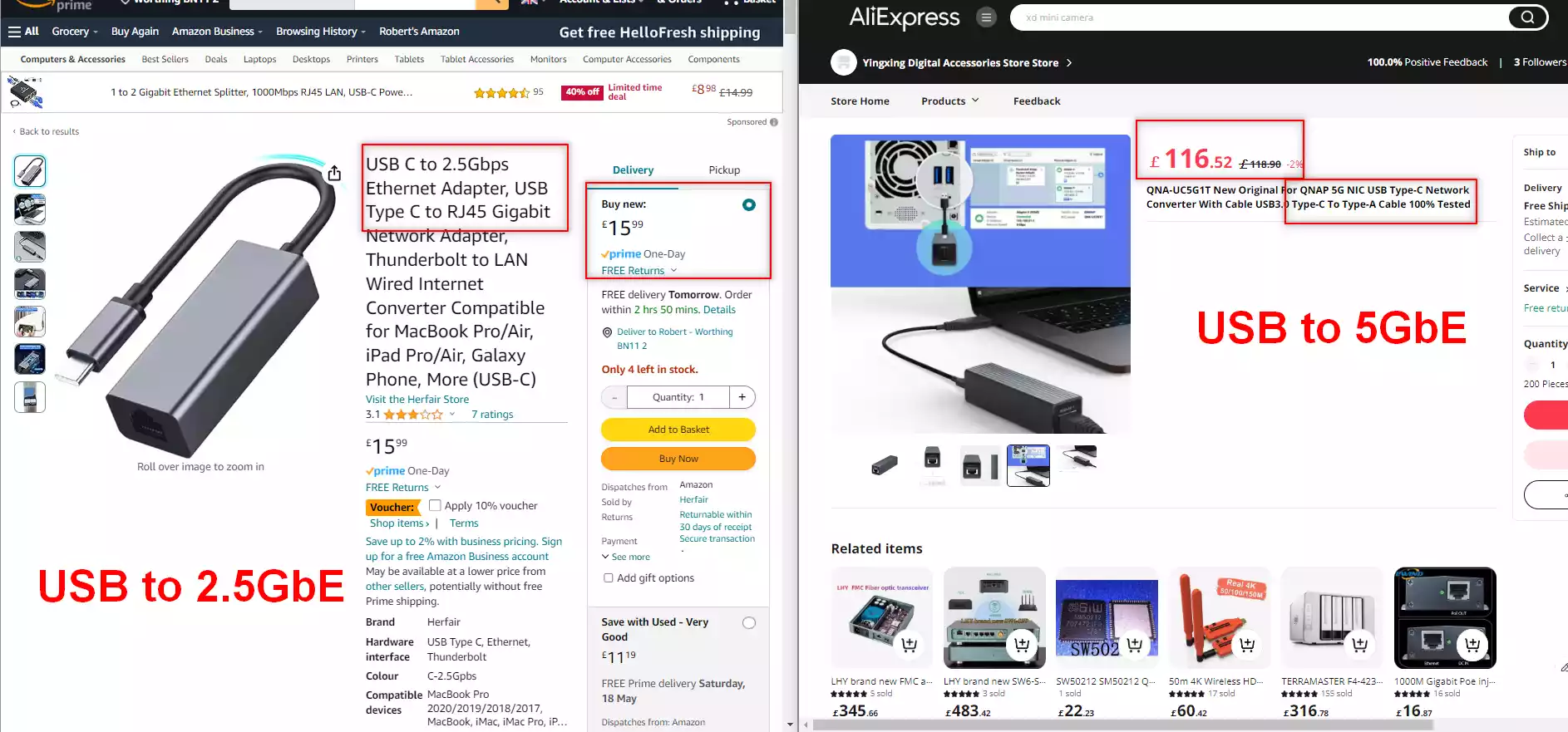
Overall the network connectivity on this device is….fine, I guess. It certainly is not going to blow you away and it is all pretty much standard. I expect this kind of thing at this price point. Anyway, the obvious bottleneck that these ports and connections are going to serve to the potential RAID performance of those internal drives is going to be a bitter pill to swallow for some users and possibly may serve as a deal-breaker for them to look elsewhere for a NAS. But how does all of this external hardware impact or profit by the internal hardware? Let’s open this up and discuss what’s inside the K100 NAS.
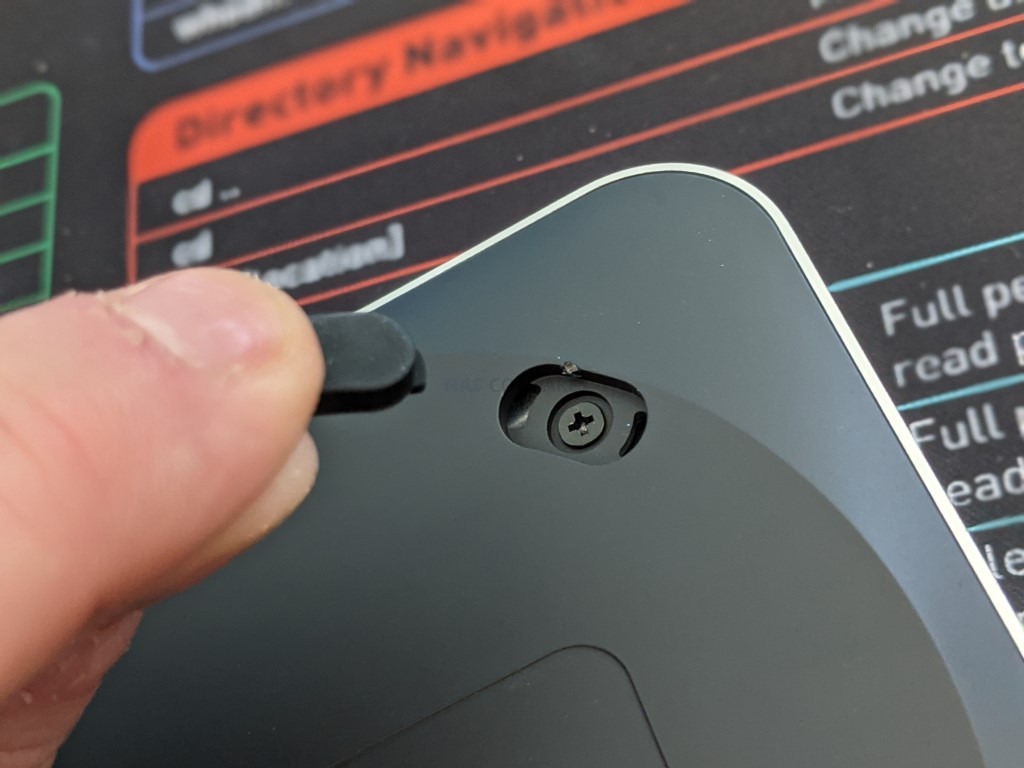
Internal hardware
The base panel of the system is removed by finding four screws located under each of the rubber feet on the base of the system. Doing so exposes an internal metal dissipation plate that lives just above each of the individual m.2 slots, serving as additional heat dissipation for the SSDs during peak use in order to prevent throttling due to high temperatures.
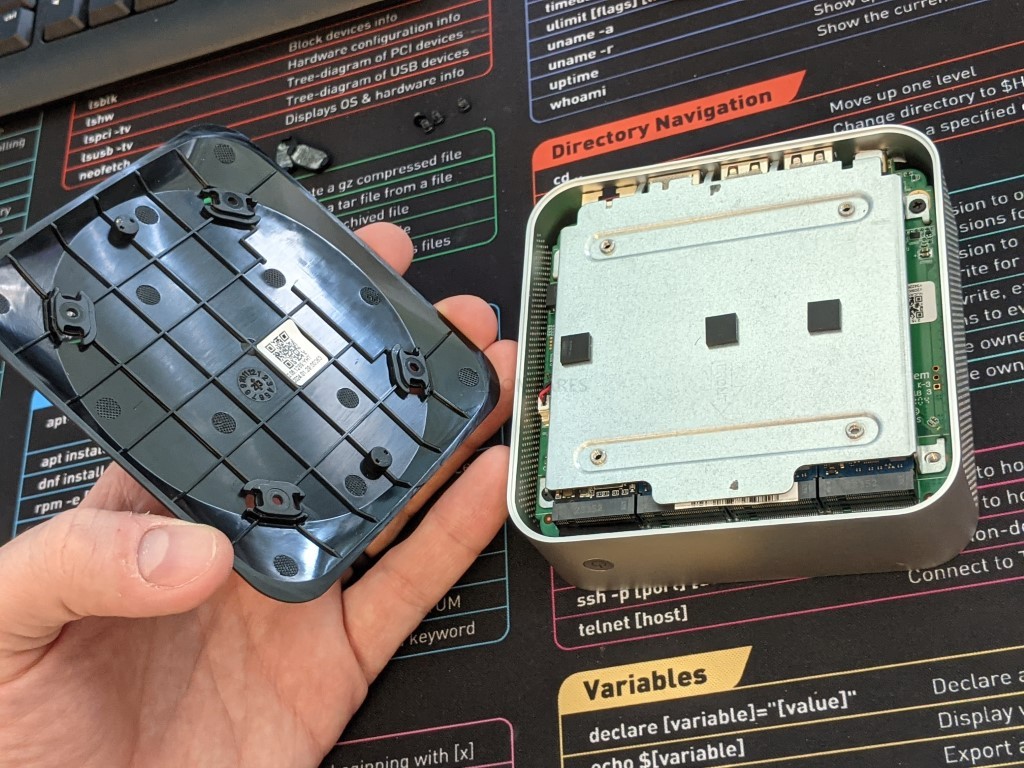
Removing this further panel with four more screws reveals all four of the internal m.2 NVMe slots. Each one is 2280 in length, and if you purchased a device pre-populated, Bay one will be already occupied with a relatively little-known SSD branded drive. Additionally, my review unit arrived with Windows 11 pre-installed on this drive. I’m not too sure if this is what every user who purchases the K100 will receive, or this is something that perhaps a previous reviewer added during their evaluation, but I think the majority of users are probably going to wipe this drive very early in favor of more NAS-focused software shortly after.

It’s also worth highlighting that when I dug into the BIOS of this system, I was able to find out that although the hardware architecture for each of these slots is PCIe Gen 3*4, each slot has been downgraded to times 2 speed. This is something that was added to minimize SSD temperature during operation. This still means that each SSD inside, if you use Gen. 3*4 SSDs, will still be afforded somewhere in the region of 2,000 MB per second bandwidth each.
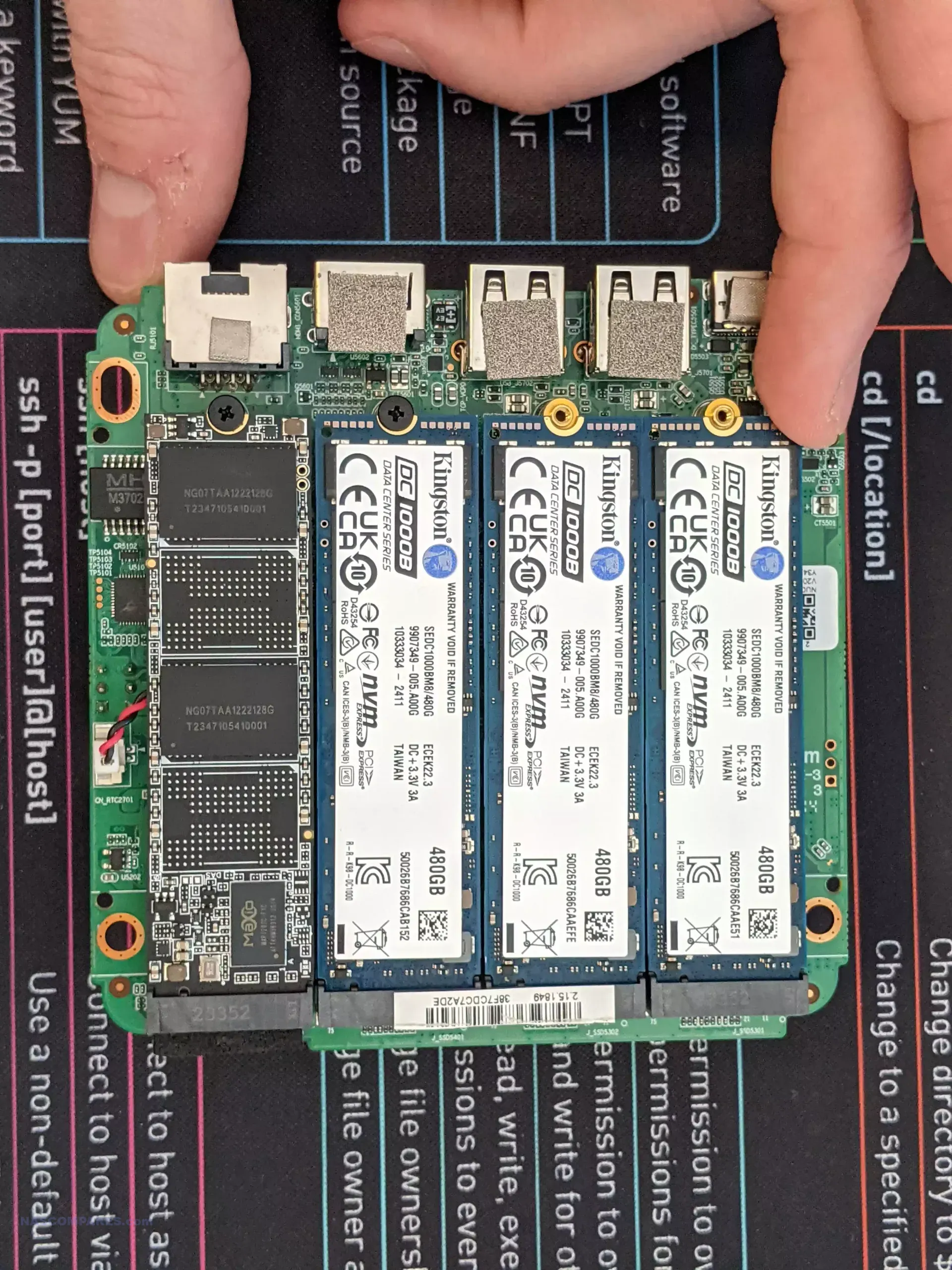
The N100 CPU that we’ll talk about in a moment is not the most powerful processor on the market, trying instead to find a better balance between performance and power consumption efficiency, so even though each of these SSDs has been afforded 2,000 MB per second of bandwidth, I very much doubt that we’re going to see this system break any records in terms of performance.
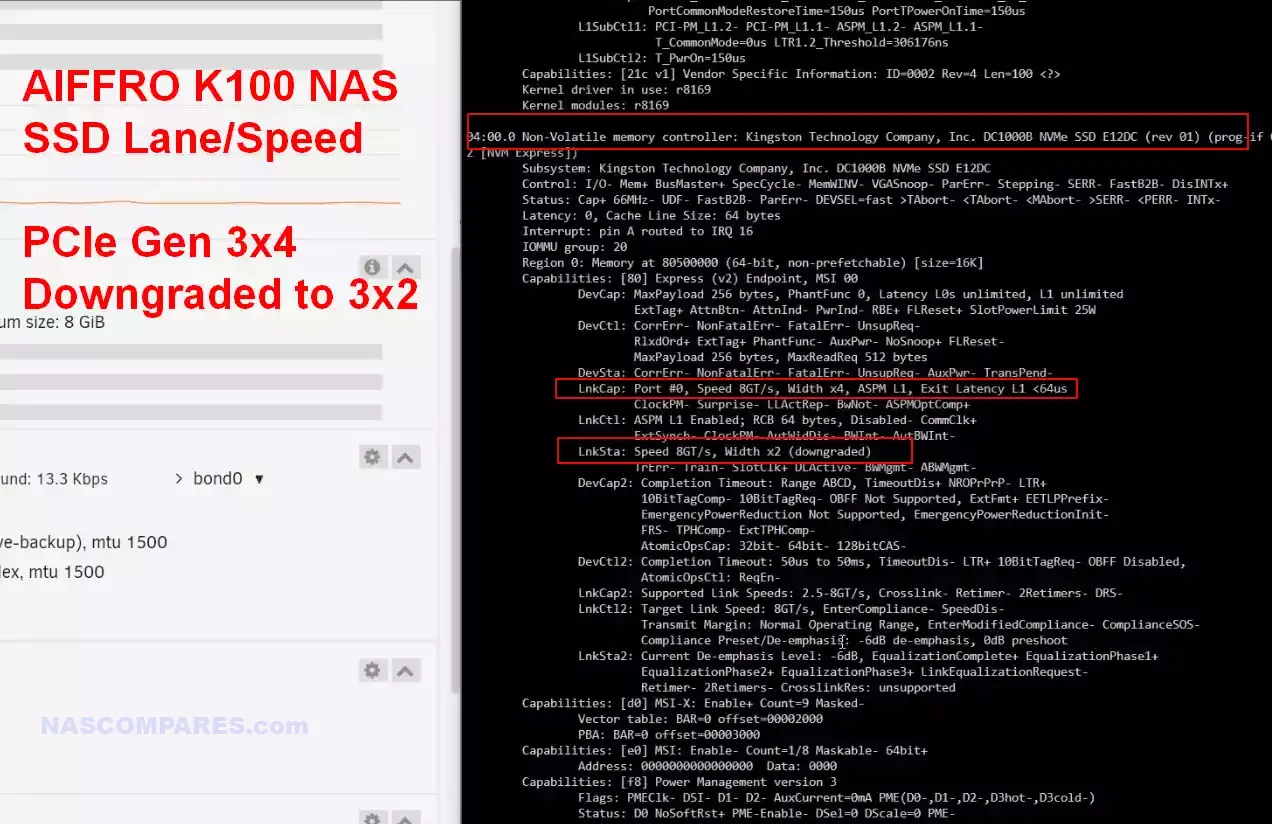
Removing this panel then exposes the internal CPU and memory configuration of the K100. This processor arrives with its own small laptop-style cooling fan and, despite its small stature, has become remarkably popular in consumer-grade NAS devices in recent years. The Intel N100 is a quad-core x86 CPU that, although has a very low base clock speed, can be boosted impressively all the way up to 3.4 GHz when needed.
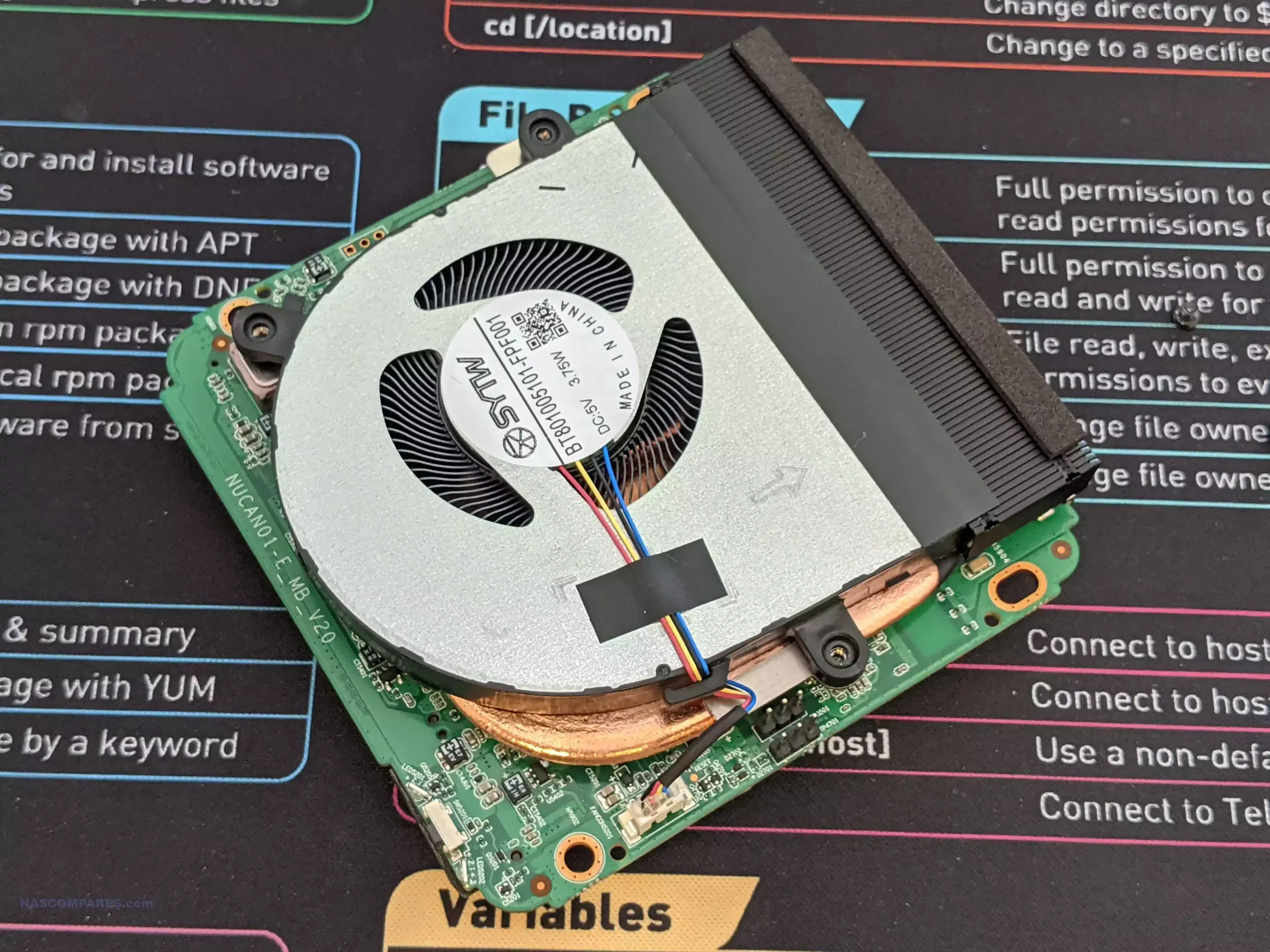
With a TDP-reported power rating of just 6 W and even arriving with a moderate level of integrated graphics, there is a lot to like about this CPU choice.
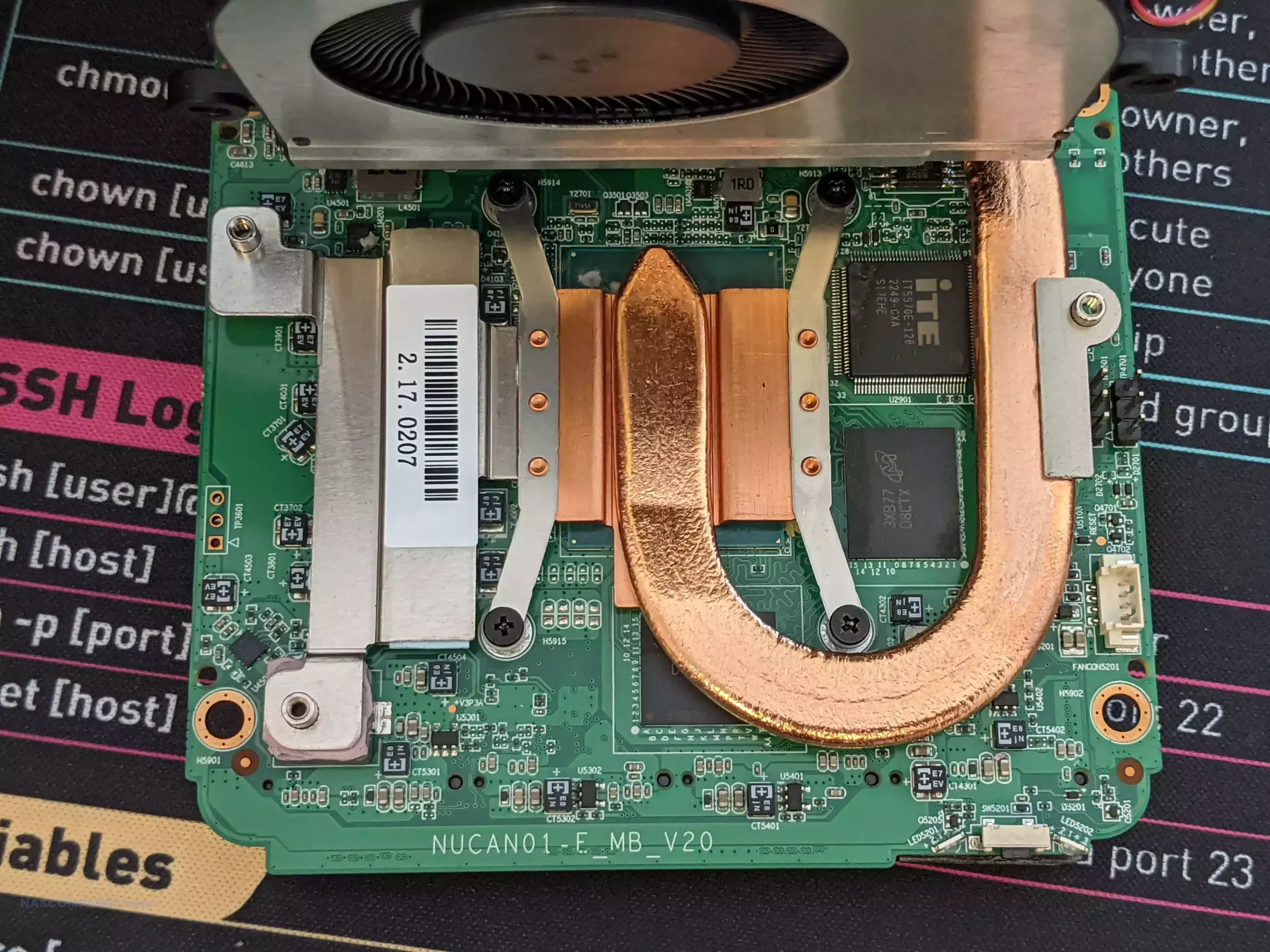
I have already tested numerous systems with this processor from CWWK, Topton, and Aooster, and on every occasion, this processor architecture did not disappoint in things like 4K Plex media server, container deployment, speedy backups, and multi-user/multi-application simultaneous usage. However, on the subject of memory, things differ ever so slightly with this modest CPU also diminishing the scope for memory allocation + features.
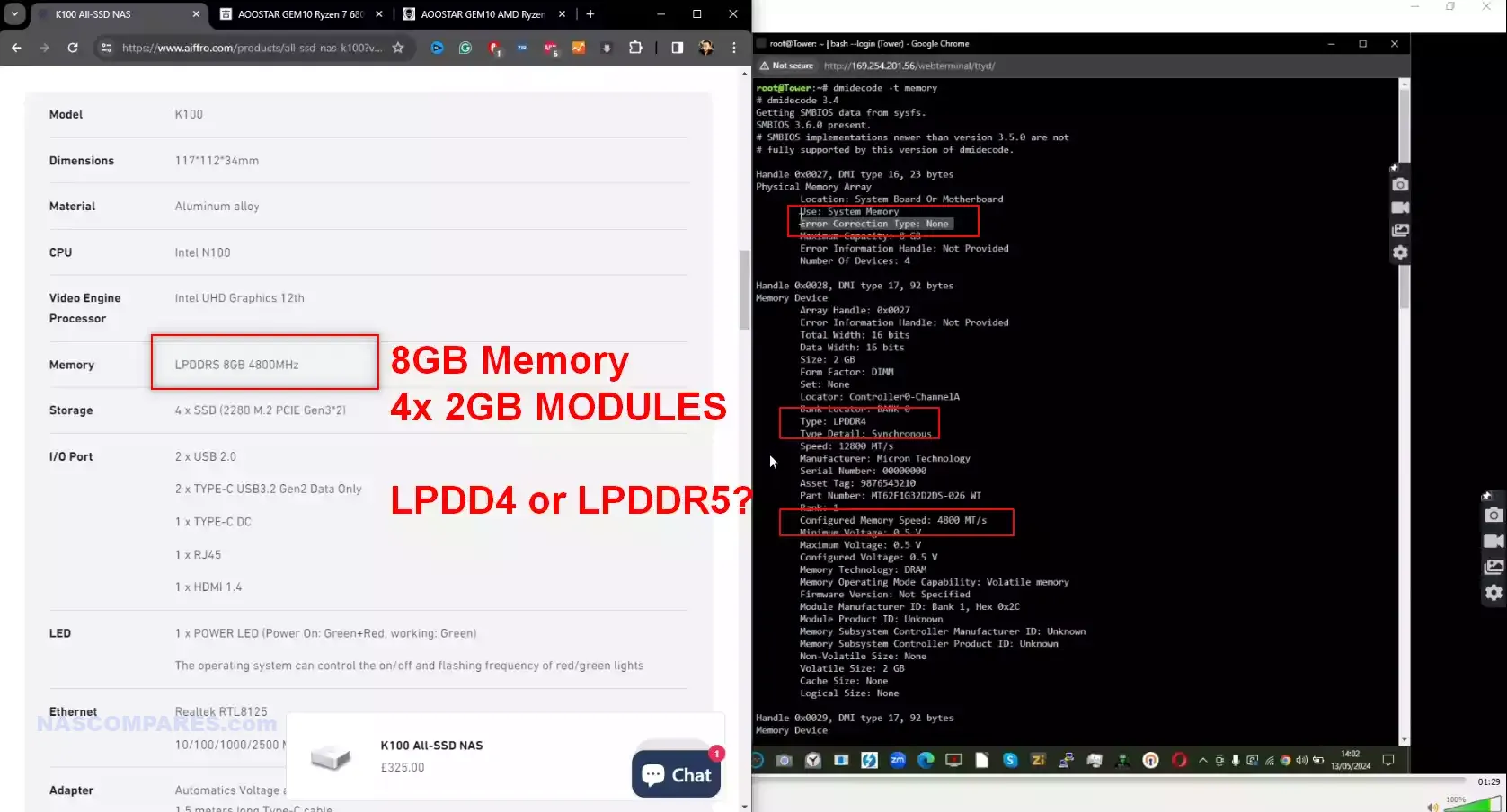
The K100 arrives with 8GB of DDR5 memory at 4800 MHz. For a base level amount of memory on any affordable NAS system, this isn’t too bad. It’s only when you move beyond this that things become problematic. For a start, this memory is provided via four times 2GB pre-soldered memory flash cells attached to the internal PCB. There is no means to upgrade the base of your memory beyond this and therefore running services such as TrueNAS are going to be a little bit more stringent when it comes to the beefier ZFS and inline services that it includes. Additionally, this processor does not support ECC memory and therefore there will be some experienced flash server users who are going to feel less secure in this faster storage media being supported by non-ECC memory – fearing occasional data inconsistencies occurring over time.
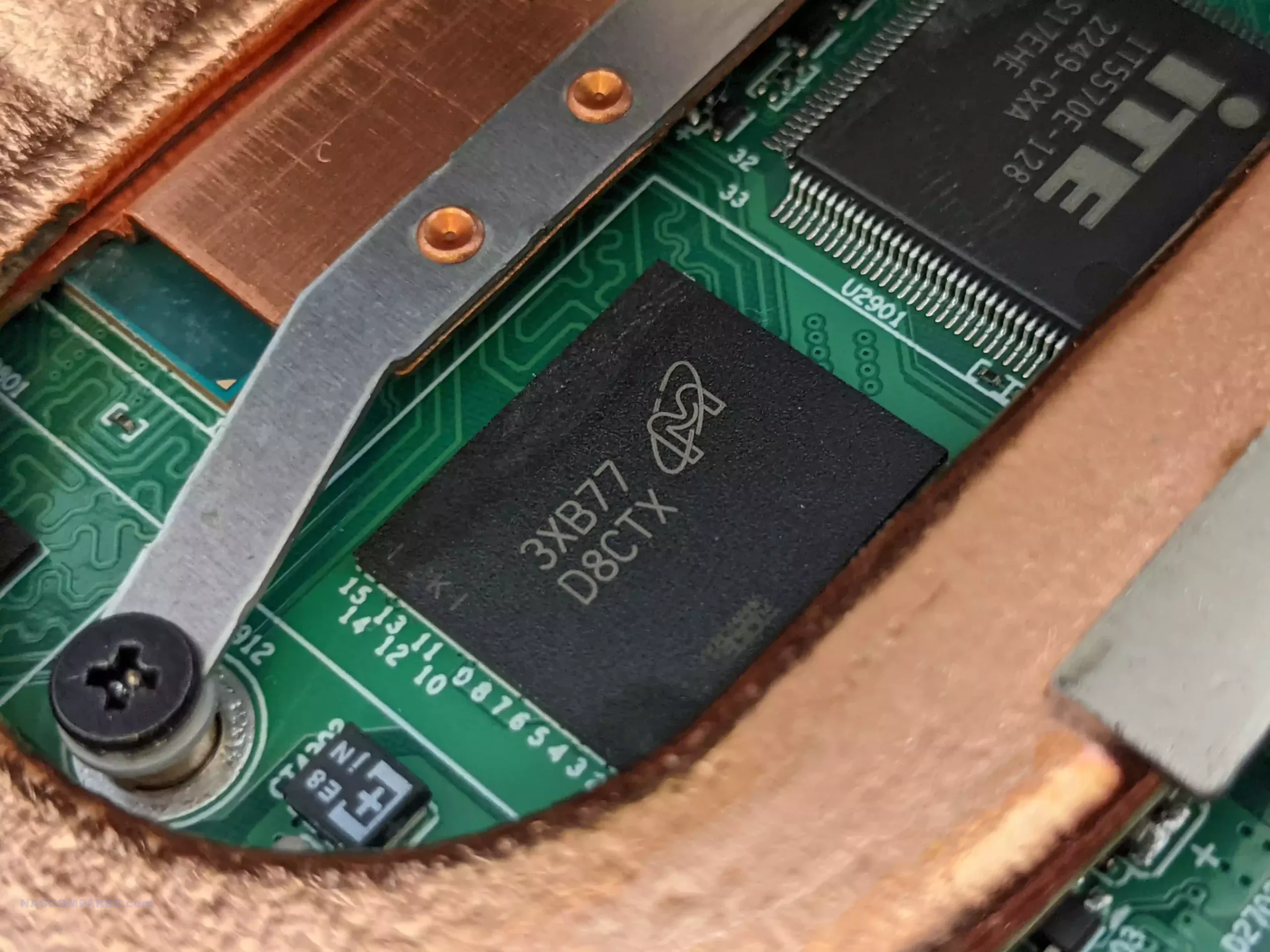
Realistically, adding the necessary architecture to equip this system with ECC RAM would have meant changing the CPU for something a little bit more expensive and swapping out the available memory for more expensive ECC modules, so I completely understand why they opted for keeping things more simple and affordable on this smaller system for that target audience seeking entry-level SSD NAS. Nevertheless, the more modest foundations of this system are definitely going to impact overall performance. Some users are obviously going to highlight that performance was already somewhat limited by that 2.5 GBE solo port, but this CPU and memory architecture is definitely going to impact internal performance too. That is possible from those four M.2 SSDs.

AIFFRO K100 SSD NAS Review – Software and Performance
As this system runs on the fantastically modest yet capable Intel N100 (x86 Architecture, 4 Core, 4 thread, 3.6Ghz peak when needed, int.GFX), as well as running on M.2 NVMe SSD Storage, it was always going to be interesting to see what the system power consumption was going to be. When the system was at idle (i.e on, but M.2s not being accessed for 15 mins, system in a ready state, but not processing), the K100 was erring around the 10W mark – perfectly acceptable.
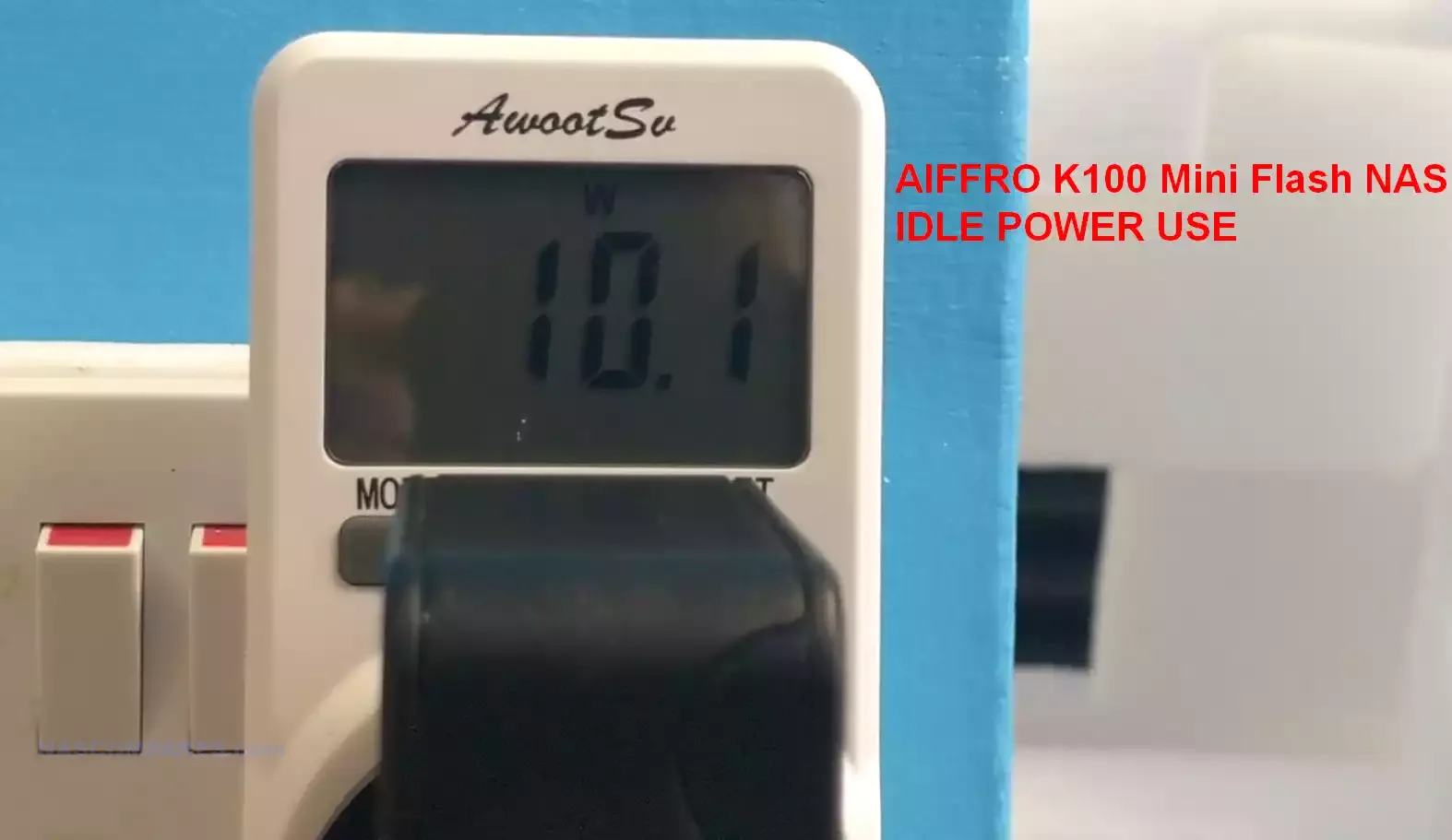
At peak, with all 4 SSDs being accessed and the CPU at 40-50% use, the K100 increased its power consumption up to 16W and eventually peaked at 18W (when the CPU use and SSD use was 75% and above). Again, very respectable numbers for a 4 bay NVMe SSD Flash NAS system.
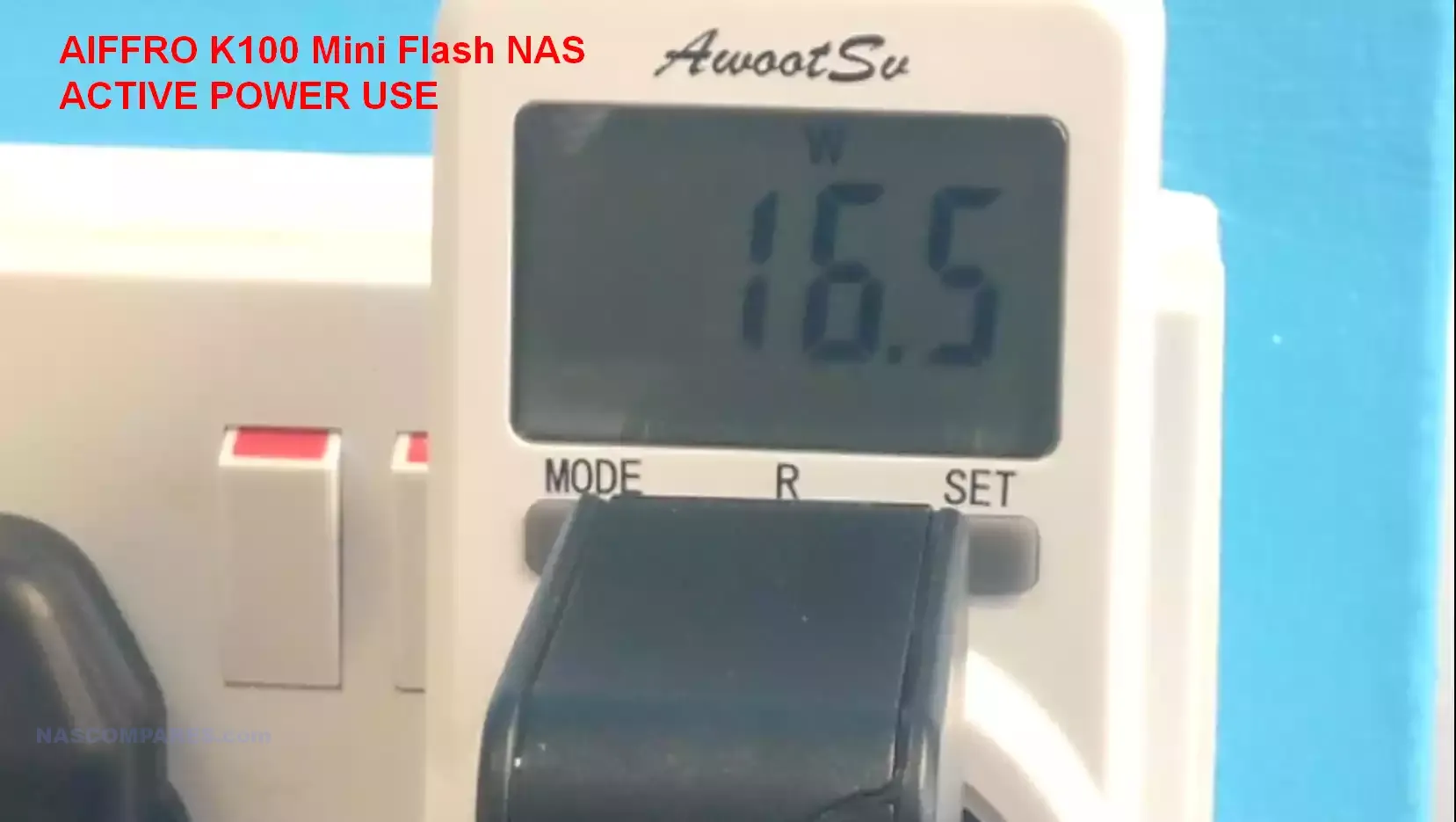
Next, we can discuss noise. Many new/old NAS users (DiY or turnkey) are moving towards SSD use in their systems primarily for decreased operational noise (and, of course, the massive speed and latency benefits). Now, upon initial boot up, the AIFFRO K100’s fan spun up to maximum speed for 15 seconds, then spun down to a much quieter idle. Initially the K100 (running UnRAID on this occasion) was around the 21-23dB mark in terms of noise, but that was when the SSDs were not mounted in the storage manager. As soon as they were mounted and even vague access was made to them, the fan spun up some more (almost preemptively preparing for heat) and the system sat at around 25-27dB noise levels. Again, not to bad, and the noise would definitely be lost in a broader office ambient environment.
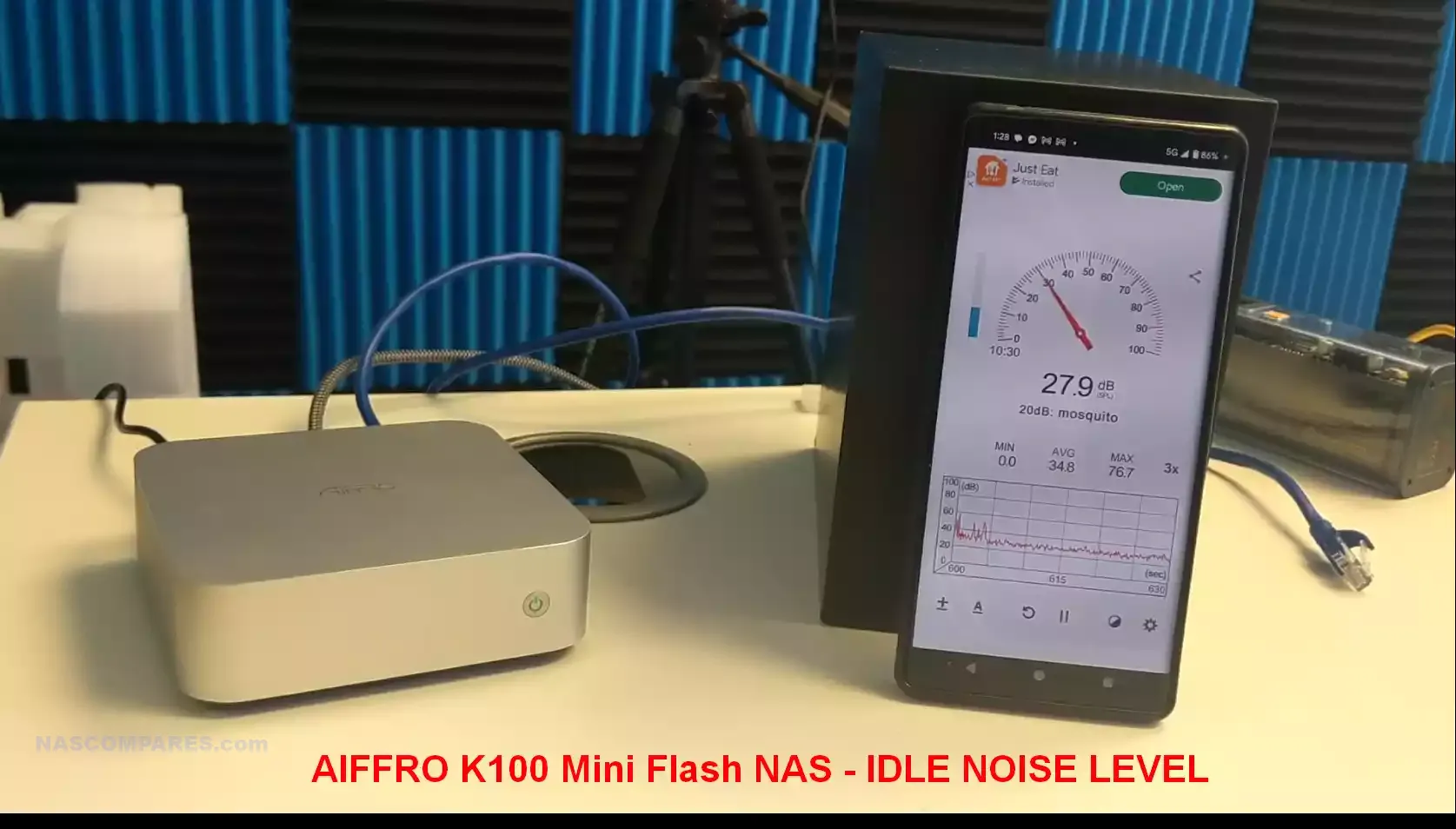
Heavy access however was a different story! Despite these M.2 NVMe drive being Gen 3×2 speed, the system still spun the fan up quickly to maximum and the K100 was hitting 36-38db. Upon the completion of ‘heavy access’, the system took almost 10 mins to naturally reduce it’s fan RPM and lower it’s ambient noise. It’s still a very quiet NAS, but the fan cooling seemed to be remarkably sensitive for an N100 NAS of this scale, especially when you factor in the pre-installed internal dissipation plate and padding on the drives.
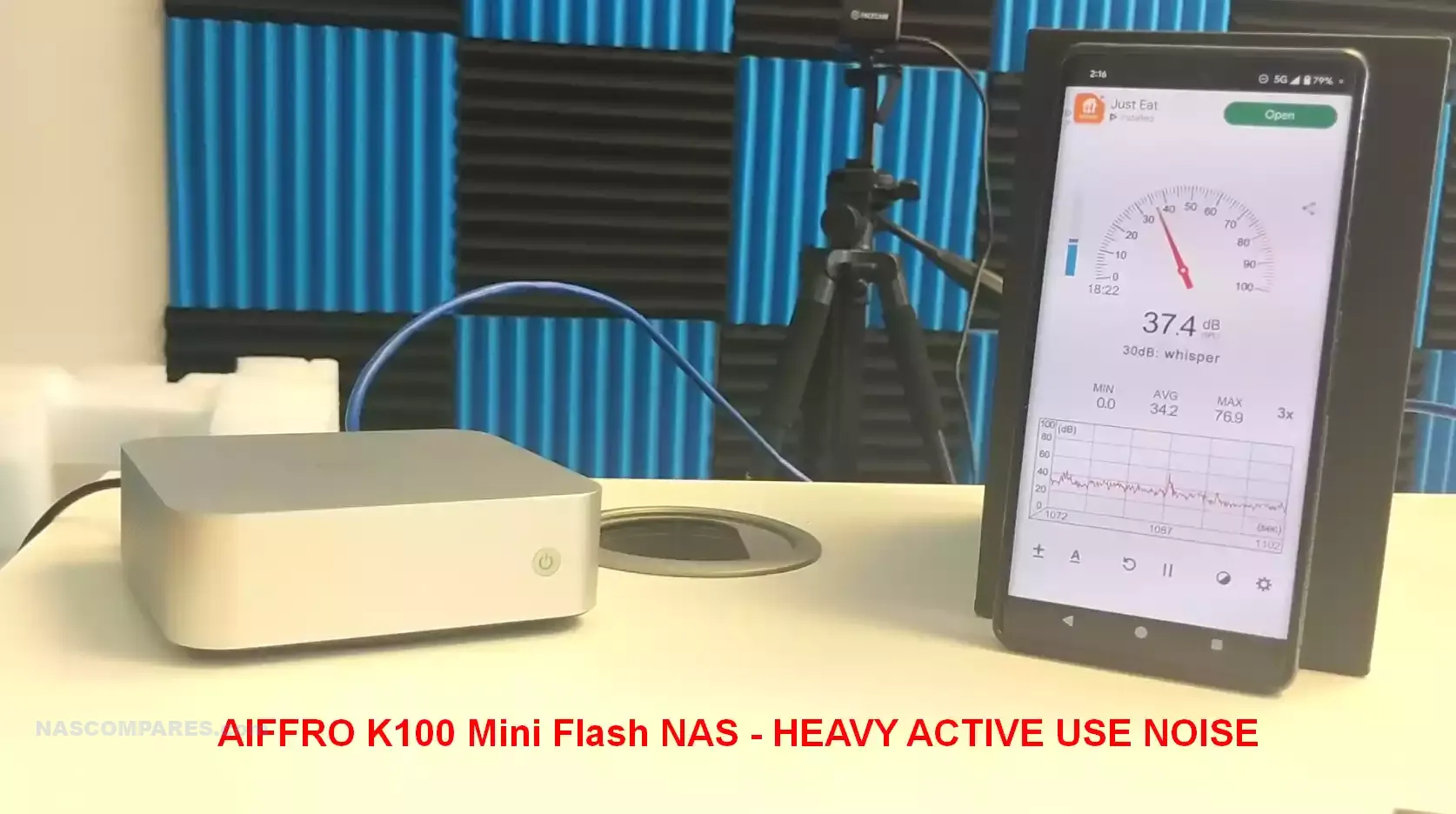
Next, we need to discuss internal performance, and unfortunately, this is where we see the shortcomings of the N100 processor when dealing with flash NVMe storage hit a hurdle or two! If people are thinking about an NVMe SSD NAS system, they are already thinking about performance in the gigabytes, not the megabytes. Unfortunately, as each M.2 NVMe is 3×2, you already have a 2000MB/s bandwidth limit on each drive already. Then it became clear in testing that these 4 M.2 are seemingly sharing some internal PCIe paths and the N100 just didn’t have the umpf to keep things moving, as initial SSD Read testing (repeated 1GB file creation) sat around the 580-600MB/s mark. When we have seen similarly powered NVMe systems to this from established NAS brands (the QNAP TBS-464 or Asustor Flashstor 6, which both ran on an Intel N5105 Celeron), we have regularly seen these SSDs only hit around 750MB/s each – so I never expected the K100 to fully saturate PCIe 3×2 – but these numbers below are only a pinch above that of SATA SSD.

On a positive note, the write performance was at least largely equal to that of Read (at 590-600MB/s), which further indicated that there was an bottleneck happening internally. I would add that this performance WAS sustained in both Read and Write – which at least would mean that operations on the K100 would be very smooth and responsive. Just that the peak performance of the M.2 NVMes inside is going to be somewhat limited.

Then, the final blow! Copying data from one M.2 NVMe SSD to another clearly indicated that bottleneck, with the average 1GB file creation speed (looped) at 270-290MB/s on average – so, effectively half of what we have seen and therefore the paths were being fought over across the SSDs and sharing out the 600MB/s or so we have seen till now.
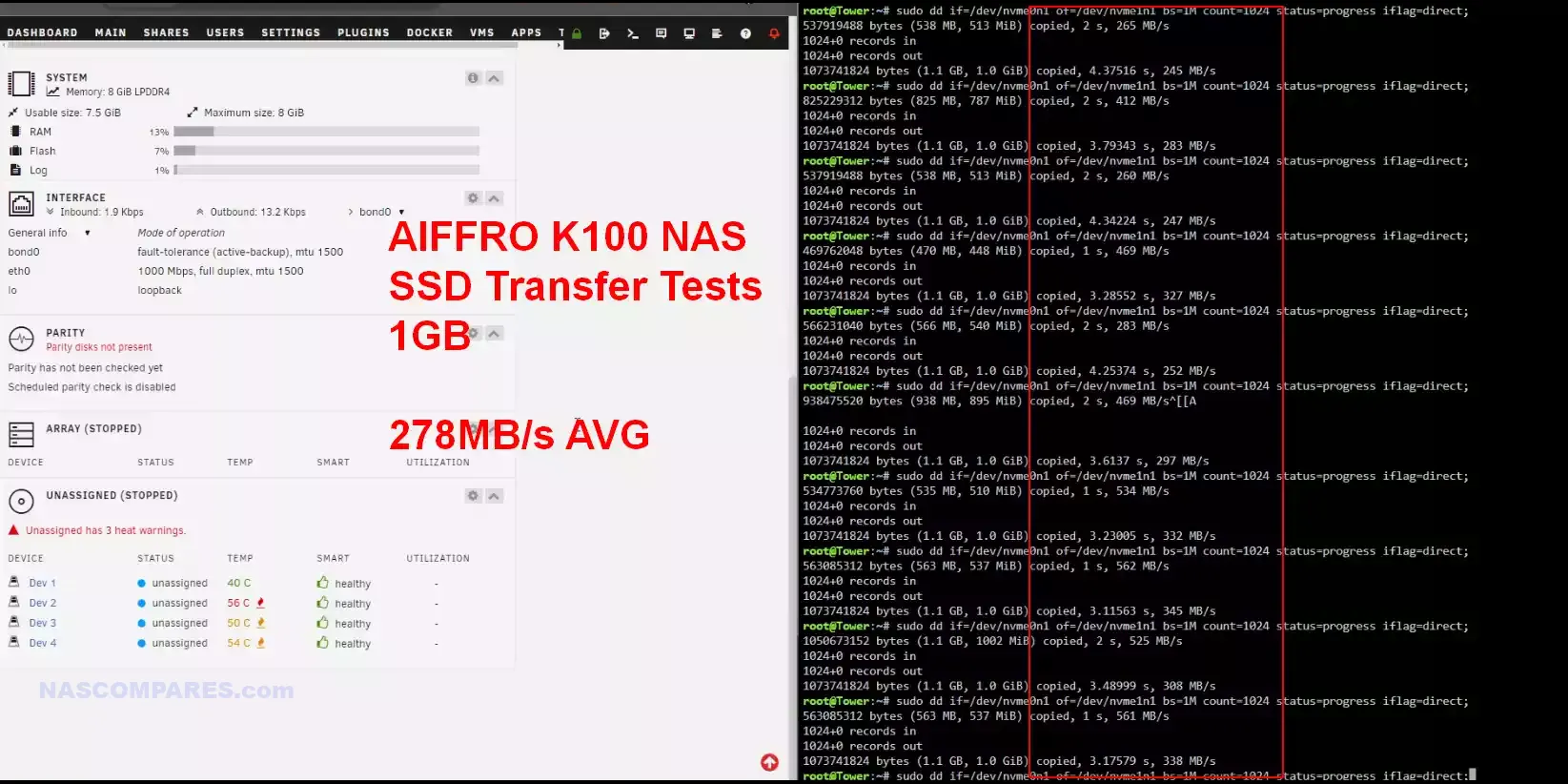
I think, at a hardware production level, there would have been an argument to play with PCIe bifurcation here and limit these M.2 NVMes to 3×1, and use some of that extra afforded resources to introduce more bays and/or improvements in the K100 NICs. Sadly, whether this was a hardware limitation, or simply that this would deviate further from the mini PC architecture (and therefore cost more in development and production), its not present here. The K100 performance feels very average, but I have to give it credit for being solid sustained performance, as well as low power consumption and largely low system noise for the majority of the testing.
AIFFRO K100 SSD NAS Review – Conclusion and Verdict
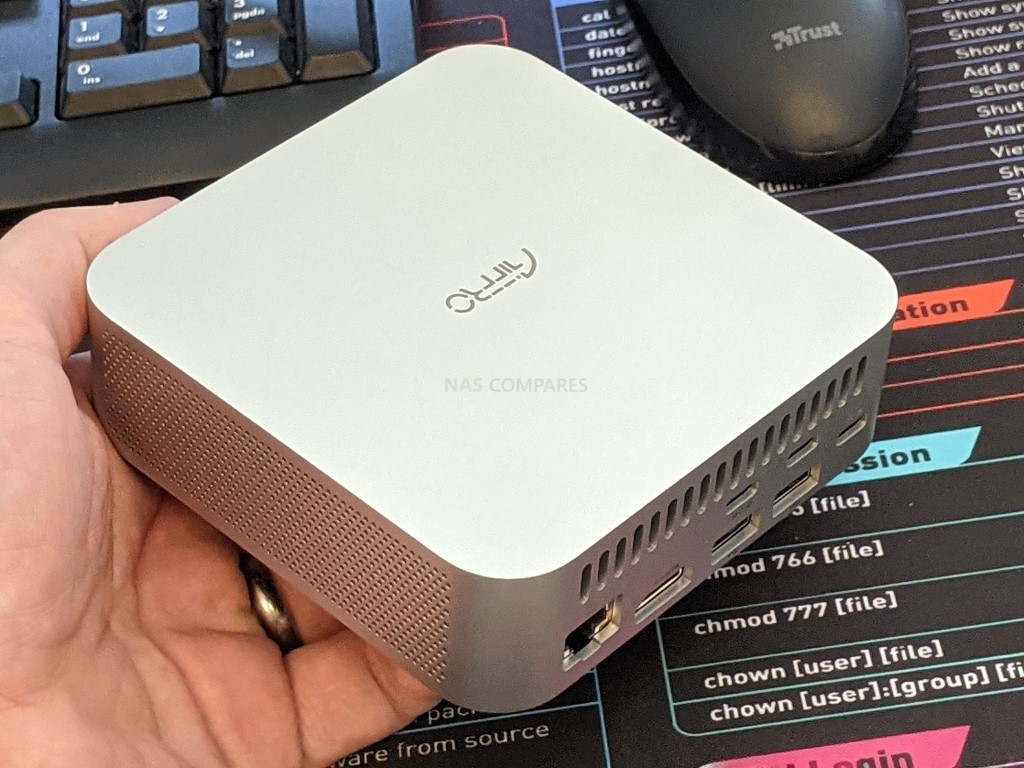
The K100 4-Bay NVMe SSD NAS is arguably quite an average NAS system, but it stands out by being one of the very few compact NAS systems that arrives at under $300 with dedicated m.2 NVMe support. There is no avoiding that very little has been done to separate it from being just a Mini PC that happens to have 4 storage slots – but at the same time, with complete NAS OS freedom, lower power consumption with USB power, good sustained performance internally (though peak performance is weak) and being genuinely pocket-sized, make this system an interesting NAS for those looking at a truly portable NAS. The single 2.5G slot is a pain though (i.e no failover and 250-279MB speed limit externally) and the fixed 8GB memory feels restrictive for TrueNAS users (let’s not even bring up ECC…), but as a first NAS from this brand on the market, it still brings competitive hardware pricing to the table. They just need to make more of a concerted effort to truly make this into a NAS system in the conventional sense. Definitely a brand to keep an eye on, but this is a system for hobbyists and homelabber’s who want something more capable than a raspberry Pi, but not for mission-critical data.
| PROS of the K100 Flash NAS | CONs of the K100 Flash NAS |
|
|
|
Where to Buy?
|
📧 SUBSCRIBE TO OUR NEWSLETTER 🔔 This description contains links to Amazon. These links will take you to some of the products mentioned in today's content. As an Amazon Associate, I earn from qualifying purchases. Visit the NASCompares Deal Finder to find the best place to buy this device in your region, based on Service, Support and Reputation - Just Search for your NAS Drive in the Box Below
🔒 Join Inner Circle
Get an alert every time something gets added to this specific article!
Need Advice on Data Storage from an Expert?
Finally, for free advice about your setup, just leave a message in the comments below here at NASCompares.com and we will get back to you.
 Need Help?
Where possible (and where appropriate) please provide as much information about your requirements, as then I can arrange the best answer and solution to your needs. Do not worry about your e-mail address being required, it will NOT be used in a mailing list and will NOT be used in any way other than to respond to your enquiry.
Need Help?
Where possible (and where appropriate) please provide as much information about your requirements, as then I can arrange the best answer and solution to your needs. Do not worry about your e-mail address being required, it will NOT be used in a mailing list and will NOT be used in any way other than to respond to your enquiry.
TRY CHAT
Terms and Conditions


The BEST NAS of 2026.... ALREADY??? (UnifyDrive UP6)
How Much RAM Do You Need in Your NAS?
A Buyer's Guide to Travel Routers - GET IT RIGHT, FIRST TIME
Jonsbo N6 DIY NAS Case Review
The Best Bits (and Worst Bits) of NAS of 2025!
Minisforum MS-02 Ultra Review
Access content via Patreon or KO-FI
Discover more from NAS Compares
Subscribe to get the latest posts sent to your email.


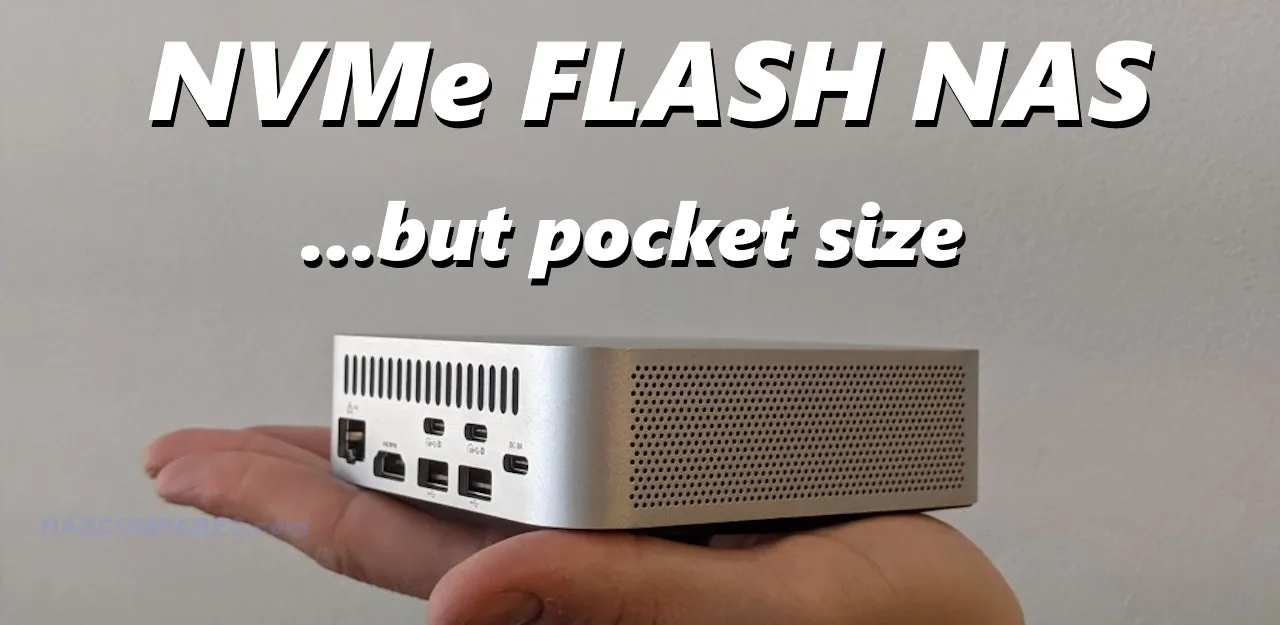



Very informative. Bro you have tactical teeth. 5meters apart and staggered.
REPLY ON YOUTUBE
I enjoyed your review, but I think you’re a little harsh on this product and your criticisms mainly apply to the whole product category. I think it’s a good deal right now.
This NAS has a lovely form factor, good speeds for the category, decent thermals, runs quiet and cool. Idle power consumption is extremely competitive – Jeff measured 6W.
I was able to buy this with a 256GB SSD for the boot drive for £194 posted and might need to pay £40 in taxes if unlucky. It is not more expensive than the beelink any more. I plan to use it as an ultra low power NVR, for which it seems ideal. We shall see!
REPLY ON YOUTUBE
I love your content, your energy and knowledge is great.
Halfway through this video and for the first time I find I’m feeling inadequate for only wanting one 2.5G ethernet port.
Will you manage to review more of the product, before you drop kick it out the window with my dreams ????
Thanks for the videos
REPLY ON YOUTUBE
the 2 biggest with all those nas issues are heat and a brrel power plug that is unsecured.
the latter is a absolutly underated big issue specially on a nas.
you really dont want accidental powerloss on a nas, and you really really really dont want it with consumer nvmes that dont have capacitors to store unwritten last data
REPLY ON YOUTUBE
Not worth it, given the price.
REPLY ON YOUTUBE
You are a bag of wind, sir. Do you know what the SOHO market is? For people and small companies living on a gigabit network, having a 2.5Gb Lan port lets us upgrade our small network to 2.5Ghz without replacing our wiring or Wi-Fi. I’m still running an old spinning disk Synology NAS which is was slow. I am more concerned about the down rated PCI bus. I think your much learning has driven you mad my friend. Poorly done because you focused on the wrong things… one port??? Did you not see the 10Gb USB-C ports? Did you test either of them with a 5Gb or 10Gb adapter??? NO! You failed us with your diatribe about a single Ethernet port when the answer was staring you in the face. I wanted to know if you did the test could you saturate those faster links or did the down rated PCI bus interfere with that… that would have been helpful.
REPLY ON YOUTUBE
I guess they could instantly improve it for very little in BOM increase by swapping RTL8125 for RTL8126, which is 5Gbps at under 1.5W — still within the limit of 1x PCIe gen 3 if I’m not mistaken. I mean, it’s been out for over a year now.
However, not that many affordable 10G switches around, so right now, less useful than 2×2.5Gbps on something like TBS-464…
REPLY ON YOUTUBE
Am I right to say that the OS is installed on 1 of the installed NVME SSDs? I remember seeing 1 of those nvme nas where they included a small 2230 ssd just for the OS itself.
REPLY ON YOUTUBE
I’m a tiny bit confused: You seem quite critical of this little box not having a built-in wifi card and also that it was downgraded the PCIe gen 3 x 4 (maybe due to excessive heat generation in such a little box?) However… I just bought an Asustor Flashstor 6 FS6706T (yes, Gen 1 because of a lack of integrated GPU for transcoding) which you have previously reviewed multiple times. As you know, it’s a much larger unit with lots of internal space yet it does not have a built-in wifi card and, if I’m not mistaken, if you populate all 6 of its M.2 NVMe slots in RAID 5 (common), then it will be running with PCIe Gen 3 x1 for its NVMe SSD slots, meaning “each drive connects to the NAS via a PCIe 3.0 lane with a single lane width, which is considered relatively slower compared to higher PCIe lane configurations when in a RAID 5 configuration; however, the overall performance is still significantly faster than traditional SATA drives due to the NVMe SSDs themselves”.
So, having said that, why did you not give the same harsh review of the FS6706T having just 1 Gen 3 lane and no wifi? I’m mostly just curious since my new NAS lacks both PCIe Gen 3×4 and wifi support.
REPLY ON YOUTUBE
If you’re using it as a nas as intended, then it absolutely does not need wifi. You’re gonna chuck it next to the router and leave it plugged to ethernet
FFS what a stupid thing to complain about
REPLY ON YOUTUBE
Would have the potential to be a nice Plex server, but apparantly the fan makes more noise than the one on my Synology 918+.
REPLY ON YOUTUBE
How do you think it would perform with proxmox for home assistant and Plex ?
REPLY ON YOUTUBE
I am a newbie when it comes to networking and NAS solutions, but I have a idea of one I want to try but I’m unsure if it’s feasibility. My solution to a small NAS is to use a mini-PC (Beelink Mini S12 Mini PC) with a 128GB NVME M.2 for the OS and Urbackup as the NAS software solution, a 4Tb SATA 2.5 SSD for interior storage expansion. That’s for the first part, the further expansion plan is to attach a 4 Bay HDD Cage Chassis, connecting it to the Beelink through a NVME M-Key PCI Express to SATA 3.0 Adapter Converter Hard Drive Extension Card. My only unsure portion of the NAS, is my decision to power the 4 Bay Chassis using a Pico UPS (24pin DC ATX PSU 12V DC Input DC 12V 150-watt Pico PSU) as the power source attaching a COMeap ATX Power Jumper Cable to turn the chassis on/off. On paper it seems as if it should work but of course like I stated I’m a newbie. What do you think? Would it work?
REPLY ON YOUTUBE
overpriced
REPLY ON YOUTUBE
I’ve seen a couple of reviews complain about the lack of wifi on a NAS. Why is that a dealbreaker? When I think of NAS, I don’t think of wifi.
REPLY ON YOUTUBE
Put a dual sfp28 nic in install ceph get more ram so you can put in at least 4 nvme drives. So you can build your low power cluster able to really scale. A dual sfp28 will give you 7 Gigabytes per second band with that will be stunning for every home lab and small businesses using proxmox.
REPLY ON YOUTUBE
there is no point having ssd nas without a 10gb nic , i add ssd in my server only after i install a 10gb nic , i had for long time a quad port 1g nic on my server and workstation ,
REPLY ON YOUTUBE
Interesting, looks like my previous comment got removed…. Either way, to say it again, many of the N100 boxes currently being sold are way overpriced. I’ve got a variety of the N100 including Trigkey boxes from Amazon, and Firewall-style box (4x 2.5GbE). But the best one is a barebone N100 with 2×2.5GbE NICS (Intel) and 2x NVMe bays, that I’m using for a CEPH cluster, and they cost me less than £100 each from AliExpress.
REPLY ON YOUTUBE
WiFi,.. yeah, no thanks, rather have two wired ports, but even then, it really only needs one if it’s on a home network with no internet connection.
REPLY ON YOUTUBE
Pair it with a NICGIGA switch for perfect synergy.
REPLY ON YOUTUBE
this gets pretty close to making the compromises I’d want, tbh, I prefer an all-flash NAS just for footprint and noise in my apartment, I even only have 2.5GBe on my router, but 4 drives isn’t quite enough, I’d still need expensive 4TB drives, and this is neither cheap enough to offset that, nor expandable enough to let me work around it. I’m pretty sure my next NAS is going to look a lot like this though.
REPLY ON YOUTUBE
Absolute newbie to this area and wanted to ask this community questions about upgrading my system to support a “big data” project.
My project is software than has to analyze ~10TB of medical data.
The issues/concerns I have with my current setup are: 1) data transfer speed; and 2) capacity. The data is already backed up on offline drives so I am not concerned with RAID redundancy. I am trying to decide whether to buy a new computer and/or add a NAS (and if so what kind -HDD, SSD, or hybrid).
I have an Alienware R11 (thus PCIe Gen 3), with 32GB of RAM, a 2.5Gb network connection. It has two NVMe slots, one is occupied with a 1TB SSD on which the operating system is stored. In the other slot I installed an 8TB Sabrent Rocket 4 SSD. I have also installed two WD Ultrastar 22TB HDDs.
The issue is that the 8TB SSD speed is limited by the motherboard and is also too small to hold all the data. Data transfer speeds from the HDDs max at ~250MB/sec.
Thus, it takes many hours (almost a day) to read the data.
I want a system at least twice as fast with at least 30TB capacity.
Do I buy a new computer with Gen 4/5 PCIe and more NVMe slots that I load with the max TB SSDs I can afford and split the data across (suggestions for specific models appreciated)? Or do I add a NAS (again, suggestions appreciated)? Or do I do both?
Internet wizards share your wisdom!
REPLY ON YOUTUBE
It’s DDR5, you can check by it’s part number and 4800 MT/s speed.
REPLY ON YOUTUBE
can this be used as just a DAS ? im looking for m.2 das
REPLY ON YOUTUBE
It’s a NAS with “only one 2.5GbE” but what is its purpose? If you have 10GbE and are able to drive the SSDs hard how are you going to cool it and what are you connecting to it? I would contend that this is not a NAS designed with SSDs to be a power box but the physically smallest, portable NAS device they could produce – necessarily requiring the physically smallest storage devices – to put in a bag and take with you … and it fits that brief reasonably well. I think it seems overpriced for the benefit of portability but I’m not their target market.
REPLY ON YOUTUBE
4x nvme … and still no 10Gbe … what’s next ? 12x sata connected via usb 1.1 ?
REPLY ON YOUTUBE
£365 for 256Gb……WOW. Bang for the buck, isn’t this.
REPLY ON YOUTUBE
Usbc speeds?
REPLY ON YOUTUBE
N100, that chip has a total lack of pci lanes. Why do you think it has so little connectivity.
REPLY ON YOUTUBE
I want one
REPLY ON YOUTUBE
The price makes it something of a joke. If you want a 8GB RAM, 4 way NVMe SSD, with a single 2.5Gbps network port you can purchase the ARM based CM3588 board for under $160.
REPLY ON YOUTUBE
*update* regarding pricing on the K100, Aiffro have provided a discount code to apply a discount. I still stand by my points in the vid, but I wanted to share this here in case it’s useful. https://www.aiffro.com/discount/8KD7N23WCRWA?redirect=%2Fproducts%2Fall-ssd-nas-k100 (Discount Code 8KD7N23WCRWA)
REPLY ON YOUTUBE
Great review, but don’t understand the complaint of absence of Wifi, while nobody will use it as stated. Also would add costs, so I understand not implementing this.
REPLY ON YOUTUBE
These are home NAS’s, do you really need more than a 2.5Gbps NIC? I’d like one of these to take away with me when I’m on the road and anything that lowers the heat/power/price is ideal. Not all NAS’s have to be ‘knocking it out of the park’ performance wise. Same with PCIe lanes, no it can’t use the SSDs to their full potential, but do you need it to? All the time? Is if fast enough as it is? I guess if you’re a company and need fast NAS storage you’d go with another brand, but not all of us need that performance, especially in a home situation. For home I’d suspect that storage capacity, size and noise trumps outright performance, and I think tis is where these systems are best suited.
REPLY ON YOUTUBE
I’m planning to buy a cwwk x86 p5 with a i3 n305 and 32 gb of RAM what do you think about this model for a low power nvme nas?
REPLY ON YOUTUBE
$399 for this? lol no way.
REPLY ON YOUTUBE
“it ain’t me” ????
REPLY ON YOUTUBE
$450 help me to understand what is the value in this unit?
REPLY ON YOUTUBE
This is just not compelling enough anymore. Offerings from established players like Asustor (et al) provide so much more value. For example: Asustor AS5402t has 4 nvme slots AND 2 sata drive slots AND 2 x 2.5gbe ports, for $369 US on Amazon. That’s only $44 more for a turnkey NAS.
REPLY ON YOUTUBE
All of the N100 devices seem to hit a bottleneck on their pcie lanes. I’m starting to think the cpu throttles them rather than it being other circuitry. So they are handy to get 2/4 drives deep, but struggle if you try to use more than one at once. That’s semi acceptable at cwwk prices, but this is way more money. Hmm.
REPLY ON YOUTUBE
Portable computers get smaller and pricier. Port elimination is not consistent with real life. I still need them, but now have to pay extra and manage the logistics of 2 devices plus tons of cables…
REPLY ON YOUTUBE
At that price, I can’t justify getting one. 4 x pcie3 drives in that tiny space is gonna bake something.
REPLY ON YOUTUBE
N100 is good for a lot of things but lacks the pcie lanes to make a good flash NAS. Not that something that small and low power wouldn’t have use cases, I could definitely see using something like that while travelling or on location, price is way too high though and it’s a shame almost none of these support 22110 drives.
REPLY ON YOUTUBE
When I travel with the family, I bring a MiniPC with 2 4TB nvme drives as a mobile plex/jellyfin minecraft server. This would double the amount of storage within a power budget that can be run off of a powerbank on a cross country flight.
REPLY ON YOUTUBE
I recently bought new mobo with N305 on Ali and put 1x 48GB DDR5, It has 4×2.5Gbps. It is a beast comparing to previous ones i.e. N6005. Considering I put there HDD and used 2x m2 as OS on mirror (zfs) – more than enough for the home NAS. This what you just presented is not really home NAS – maybe traveller storage.
REPLY ON YOUTUBE
Without 10G it is worthless.
REPLY ON YOUTUBE
does the data transfer speed saturate the 2.5G connection? if so then I don’t really see an issue with the PCIe lanes configuration..
REPLY ON YOUTUBE
This isn’t really a “NAS”. This is just a $150 DDR4 mini PC that they are marketing as a “NAS” for $300+. They just put an extra m.2 slot in a $150 mini pc and are charging double for the extra m.2 slot.
REPLY ON YOUTUBE
Piece of shit. Another Beelink. At this point in time, you can’t cram that much shit into a box that small and expect it to be reliable.
REPLY ON YOUTUBE
As someone looking to finally upgrade an old Synology 2 Bay NAS it would be good if you could cover some of the network scenarios – e.g. convert network to 2.5G – you would need switch (cost), cables, and what typical hardware – so does a newer mac have an appropriate LAN port, do PCs generally support it – if not what do you need. If you do manage to get 2.5G network would SSD based NAS be overkill. You also mentioned failover for dual ethernet ports – is this just for a port failure on the NAS? Or more about failover to a separate NAS?
If feels like a table / video to breakdown typical costs for 1, 2.5 and 10G ethernet and what the minimum requirements would be for the PC to support that speed.
REPLY ON YOUTUBE
N100 supports 9 PCIe lanes Gen 3, so it would make sense to get PCIE (Gen 3) x2 for all of them (x2 * 4 = 8 lanes, which does not exceed 9), CPU doing its best…
Also the reason why it’s not worth buying any flash NAS (or mini PC) when CPU was N5105 or these new N95/N97/N100/N200/N300, cause CPU won’t be able to use these SSDs to their full potential (Asustor Flashstor FS6706T is a good example of not picking the right CPU).
CPU don’t need to have huge TDP to handle number of lanes (see Ryzen V models like in Synology DS1821+/23+).
If anyone needs/wants to get full-flash NAS, make sure CPU can handle the total number of lanes (x4 * number of SSDs). TBS-h574TX (both versions) can handle 20 PCIe lanes, reason why this NAS offers 5 SSD slots (NAS is overall “balanced/relevant”). Also, NIC can book some PCIE lanes too…
REPLY ON YOUTUBE
The N100 only has 9 PCIe lanes, so that would explain the 2 lanes per drive. Given the small footprint and power requirements, I would expect this to be more something that you’d pair with a travel router and take with you than a daily use device.
REPLY ON YOUTUBE
Waiting for the flashtor gen 2. 2*10gb.. ????
REPLY ON YOUTUBE
Does someone know when we can expect new Synology nas´s? Is there a timeline?
REPLY ON YOUTUBE
What I feel worried about in these… curious brands is the reliability. In a NAS you need reliability, data redundancy, etc.
At this price point I would choose a Synology, QNAP or even TerraMaster, that I’ve been using for several years without any issues.
REPLY ON YOUTUBE
Bargh……. Why do they keep putting them out with 2.5G…. I would kill for one that would just have an SFP+ port on it
REPLY ON YOUTUBE